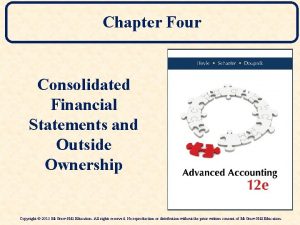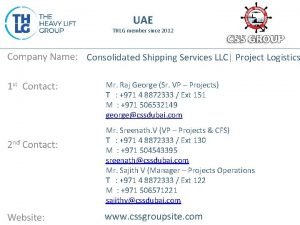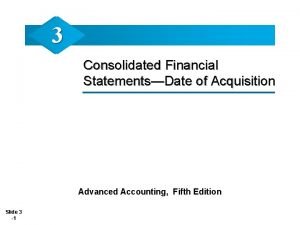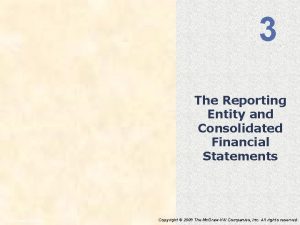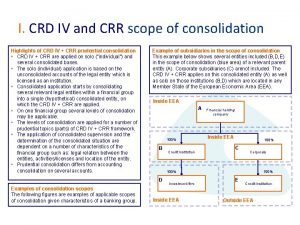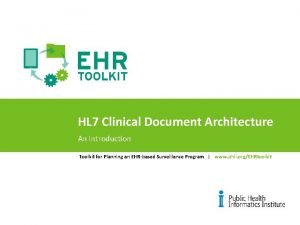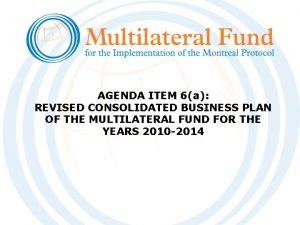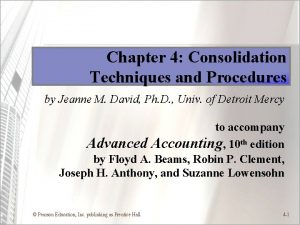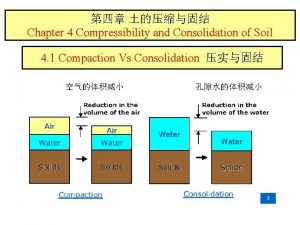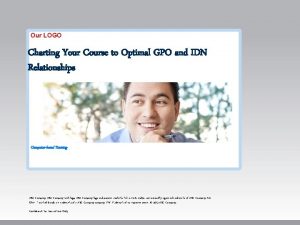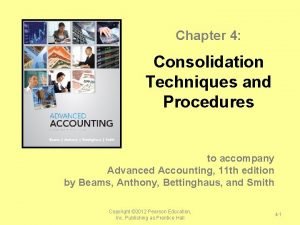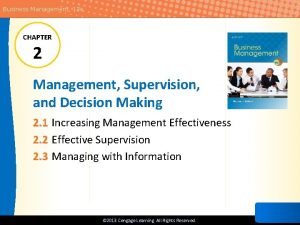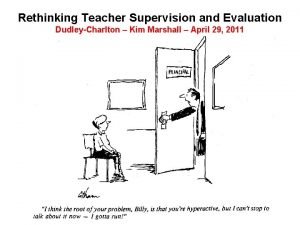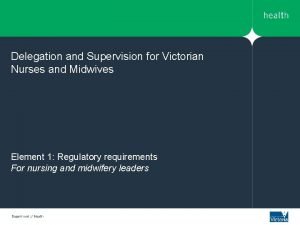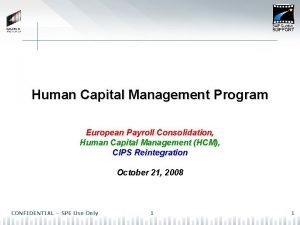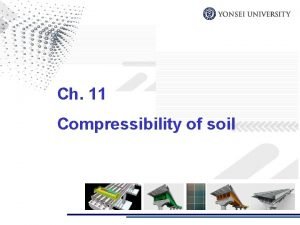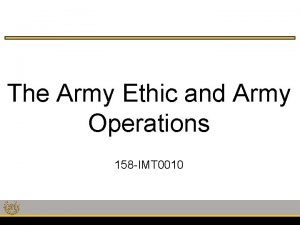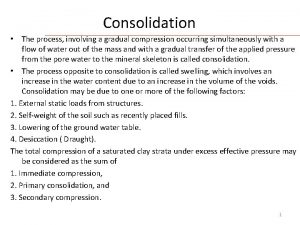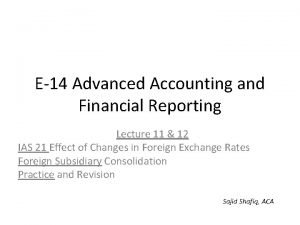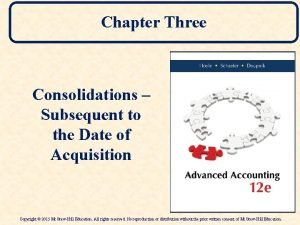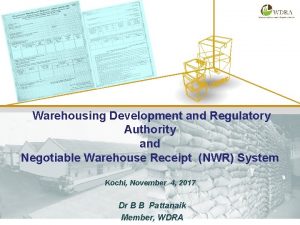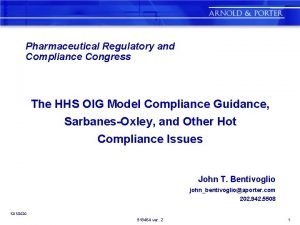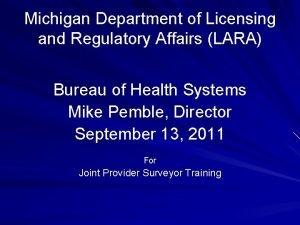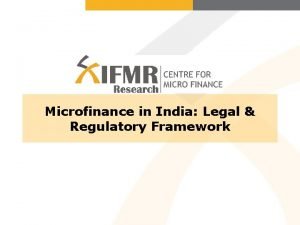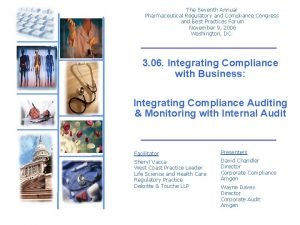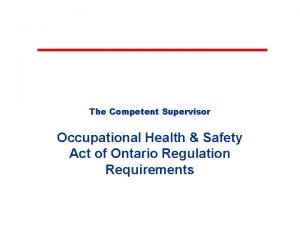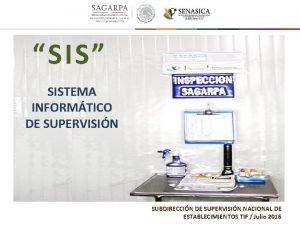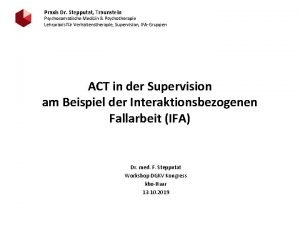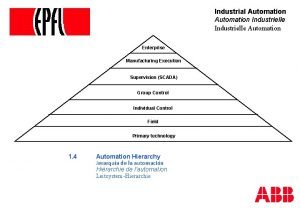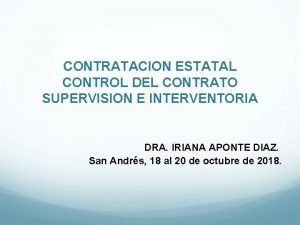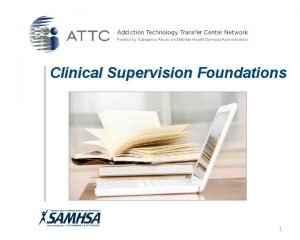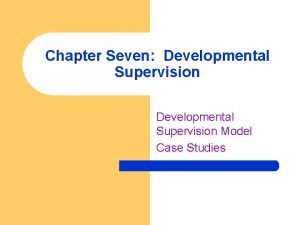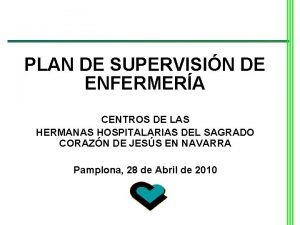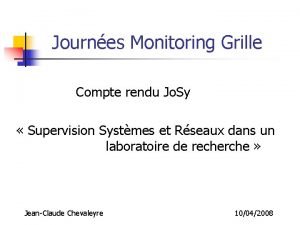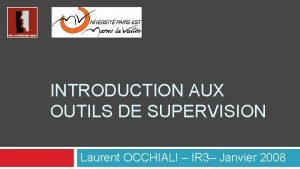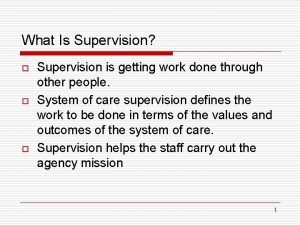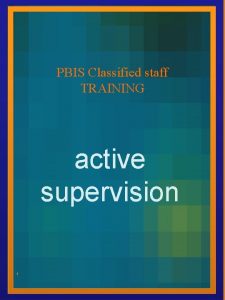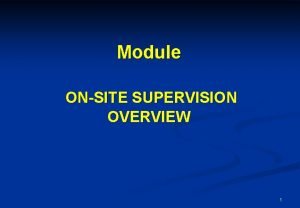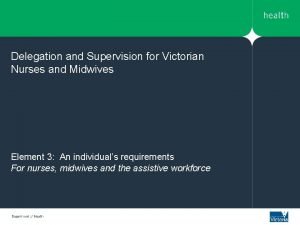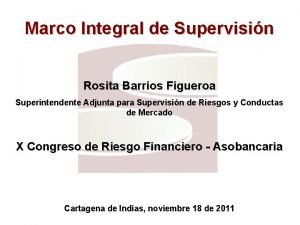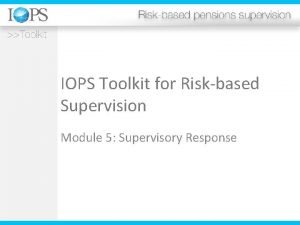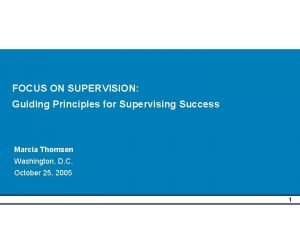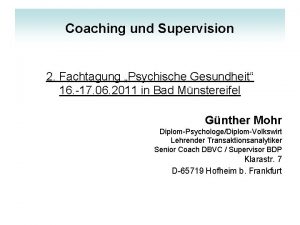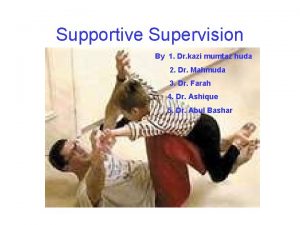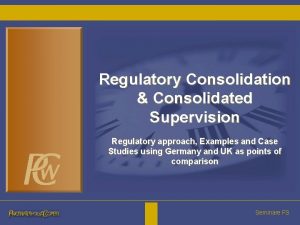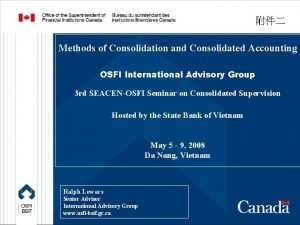Regulatory Consolidation Consolidated Supervision Regulatory approach Examples and














































































































































































- Slides: 174

Regulatory Consolidation & Consolidated Supervision Regulatory approach, Examples and Case Studies using Germany and UK as points of comparison Seminare FS

Section 1 Section 2 Section 3 Section 4 Sections: 1. Principles of Consolidated Supervision 2. Case Study A 3. Case Study B 4. Flexing Case Study B Annexes: I. Applying Consolidation Techniques II. BIS Core Principles Seminare FS

Section 1: Principles of Consolidated Supervision Section 2 Section 3 Section 4 I. Principles of Consolidated Supervision II. Applying the Principles of Consolidation in Germany and the UK III. Other Elements of Quantitative Consolidated Supervision: Large Exposures and Limits on Investments IV. Going Beyond Simple Consolidation - the Use of Flanking Policies and Qualitative Consolidated Supervision Seminare FS

Contents THE PRINCIPLES OF CONSOLIDATED SUPERVISION • The Rationale for Consolidated Supervision • • • What is Consolidated Supervision? International Standards - BIS Core Principles International Standards - Basic Legal Principles for the EU Solo and Consolidated Supervision Quantitative Consolidated Supervision 8 9 10 12 13 14 Powers of Supervisors Steps in Quantitative Consolidated Supervision 17 18 Step 1: Determining the Domain of Consolidation Step 2: Identifying the Companies to be Consolidated 19 20 – Financial Institutions – Exceptions to Consolidation – Groups subject to Consolidated Supervision Elsewhere Step 3: Techniques of Consolidation – Different approaches for Capital Adequacy and Large Exposures 21 22 23 24 26 4

Contents APPLYING THE PRINCIPLES OF CONSOLIDATION IN GERMANY AND THE UK • Main participation levels for consolidation • • • • Consolidation rules in Germany Consolidation rules in the UK Relevant Consolidation Rules in Germany Relevant Consolidation Rules in the UK Consolidation when banks have a Trading Book 28 29 30 31 32 33 Dealing with Cross Shareholdings Consolidation of Participations - Germany 35 37 Consolidation of Participations - UK General Example - Germany 39 41 General Example UK Calculating Prudential Ratios for CAD in Germany Structure of Reporting Forms for CAD reports in Germany Prudential Ratios for CAD in UK Structure of Reporting Forms for CAD reports in UK Quantitative Consolidated Supervision in the UK 42 44 45 46 47 48 49 5

Contents OTHER ELEMENTS OF QUANTITATIVE CONSOLIDATED SUPERVISION: LARGE EXPOSURES & LIMITS ON INVESTMENTS • Large Exposures Ratios - soft limits in the Trading Book • Investments in Non-Financial Institutions GOING BEYOND SIMPLE CONSOLIDATION - THE USE OF FLANKING POLICIES AND QUALITATIVE CONSOLIDATED SUPERVISION • Flanking Policies for Consolidated Supervision – – – Fitness and Properness Notification of Shareholders and Controllers Controls on Structures and Links Controls on Lending to Connected Parties Limits on Non-Financial Shareholdings Qualitative Consolidated Supervision (UK Practice) 6 51 53 54 55 56 57 58 60 61 62 63 64

Section 1: Principles of Consolidated Supervision Section 2 Section 3 I. Principles of Consolidated Supervision Section 4 Seminare FS

Principles of Consolidated Supervision Why Consolidated Supervision? Consolidated supervision is desirable because there are risks to a bank, which may pose a threat to it, arising as a result of its membership of a wider group. These risks include: · the risk that risks taken by other group companies might undermine the group as a whole; · the financial risks taken on by a bank in its links with other group companies, such as intra-group lending; and · the reputational risk to a bank if there are losses or other problems elsewhere in the group. Reputational risk is of particular concern to supervisors. It also means that even if a bank were entirely ring-fenced from the rest of its group and had no intra-group lending, problems elsewhere in the group might pose a risk to the bank. But the focus of banking supervision (solo and consolidated) remains the bank itself. The banking supervisor’s purpose in consolidated supervision is not to supervise all the companies in a group including a bank, but to supervise the bank as part of its group. The supervisor takes account of the activities of other group companies to the extent that they may have a material bearing on the reputation or financial soundness of the bank in the group. In short, supervisors are looking to spot and to prevent channels of contagion. 8

Principles of Consolidated Supervision What is Consolidated Supervision? Consolidated supervision is an overall evaluation - both quantitative and in some countries qualitative - of the strength of a group to which a bank belongs, to assess the potential impact of other group companies on the bank. The assessment is based on a number of sources of information. One source is consolidated financial returns - quantitative consolidated supervision. This is mandatory under EU law. It is also one of the key recommendations of the Basel Committee on Banking Supervision. Consolidated supervision in the UK also includes a qualitative assessment of the whole group - including the activities of group companies not incorporated in the consolidated returns, because the nature of their assets is such that their inclusion would not be meaningful (for example industrial or insurance companies). This assessment includes, for example, consideration of the controls within a group. The additional consolidated supervision beyond the quantitative assessment is known generally as qualitative consolidated supervision. 9

Principles of Consolidated Supervision International Standards - BIS Core Principles Consolidated Supervision is an important element of the 1997 BIS Core Principles for Effective Banking Supervision (see Annex II). The most relevant of these principles are Principles 18 and 20: Principle 18: “Banking supervisors must have a means of collecting, reviewing and analysing prudential reports and statistical returns from banks on a solo and consolidated basis. ” Principle 20: “An essential element of banking supervision is the ability of the supervisors to supervise the banking group on a consolidated basis. ” It is an essential element of international banking supervisory standards that supervisors should supervise the consolidated banking organisation. This includes the ability to review both banking and non-banking activities conducted by the banking organisation, either directly or indirectly (through subsidiaries and affiliates), and activities conducted at both domestic and foreign offices. Supervisors need to take into account that non-financial activities of a bank or group may pose risks to the bank. Supervisors should be aware of the overall structure of the banking organisation or group when applying their supervisory methods. Banking supervisors should also co-ordinate with other authorities responsible for supervising specific entities within the organisation's structure. 1 0

Principles of Consolidated Supervision International Standards - BIS Core Principles (Contd. ) Other BIS Core Principles are also relevant, especially for the flanking policies that accompany supervision on a consolidated basis. The following are particularly relevant: Principle 3: “The licensing authority must have the right to set criteria and reject applications for establishments that do not meet the standards set. The licensing process, at a minimum, should consist of an assessment of the banking organisation's ownership structure, directors and senior management, its operating plan and internal controls, and its projected financial condition, including its capital base; where the proposed owner or parent organisation is a foreign bank, the prior consent of its home country supervisor should be obtained. ” Principle 4: ” Banking supervisors must have the authority to review and reject any proposals to transfer significant ownership or controlling interests in existing banks to other parties. ” Principle 5: “Banking supervisors must have the authority to establish criteria for reviewing major acquisitions or investments by a bank and ensuring that corporate affiliations or structures do not expose the bank to undue risks or hinder effective supervision. ” Principle 10: “In order to prevent abuses arising from connected lending, banking supervisors must have in place requirements that banks lend to related companies and individuals on an arm's-length basis, that such extensions of credit are effectively monitored, and that other appropriate steps are taken to control or mitigate the risks. ” 1 1

Principles of Consolidated Supervision International Standards - Basic Legal Principles for EU The Banking Consolidation Directive, Directive 2000/12/EC (formerly the Second Consolidated Supervision Directive 92/30/EEC) sets minimum standards for the performance of consolidated supervision of groups including banks throughout the EEA (i. e. EU plus Norway, Iceland Liechtenstein). It also sets out requirements in respect of capital requirements to be held against large exposures and concentration risks (formerly Directive 92/121/EEC). The Capital Adequacy Directive (CAD - 93/6/EEC) - building on the Own Funds (89/299/EEC) and Solvency Ratio (89/647/EEC) Directives which established basic capital requirements in terms of credit risk - introduced both a framework for capital requirements for market risk and a requirement for a consolidated assessment of groups including investment firms. The obligations in these directives require consolidation only up to the highest relevant parent incorporated in the EEA, and not to parents outside the EEA. It is open, however, to supervisors to go further than the minimum requirements. Note: the extension of consolidation and consolidated supervision does not mean that the parent or non bank members of the group are directly supervised. Only the bank is directly supervised. The interest of banking supervisors in the parent is limited to the risks - financial and non-financial - run by the parent and other members of the group, and the extent that these may expose the bank and its depositors to risk of loss. It may be important to consolidate other parts of the group, in order to have all the relevant risks included, and this is the crucial test. Supervisors will extend consolidated supervision beyond the requirements of the directives if the result is a more accurate assessment of risk to a bank. 1 2

Principles of Consolidated Supervision Solo and Consolidated Supervision Consolidated supervision is not a panacea. It does not cure everything. Consolidated supervision is generally regarded by supervisors as a complement to, not a substitute for, solo supervision. Solo supervision is needed as well, and the importance of it is also stressed in international standards. For events elsewhere in the group and the activities of other group companies can pose a threat to the bank in ways which consolidated supervision alone cannot detect: for example, intra-group linkages arising from transactions between the bank and other group companies will only be revealed by solo supervision. A complementary assessment of solo capital adequacy and large exposures also permits a supervisory assessment of whethere is an appropriate distribution of capital in a group. Institutions are therefore required to meet capital adequacy and large exposure obligations on both a solo and a consolidated basis. The latest consultation paper from the Basel Committee on the reform of the Capital Accord has underscored the importance of solo supervision and ensuring that there is an adequate distribution of capital around the group. Supervision on a consolidated basis is also supported by a number of flanking policies. These are discussed later in this Section. 1 3

Principles of Consolidated Supervision Quantitative Consolidated Supervision Capital adequacy A bank is required to maintain adequate capital at all times. A bank is set a consolidated capital requirement in addition to that set on a solo basis. Generally, the same principles are used for calculating the consolidated ratios as the solo ratios. The required capital ratio set on a consolidated basis is normally the same as that set on a solo basis for the principal bank in the group, although UK practice is somewhat different from German practice. Where a bank fails to meet its consolidated capital ratio, supervisors considers whether this poses a threat to the bank. If they consider that the situation involves a threat to the bank and to depositors they will take action. • If the bank is the parent company of the group, they will consider whether the bank is being run prudently. • If the bank is not the parent company of the group, supervisors consider what action is needed to protect the bank. It may also consider whether the bank continues to be run prudently. The action needed may be, for example, to pursue the controller of the group for a rectification of the capital position, to require better liquidity or to restrict lending to other group companies. 1 4

Principles of Consolidated Supervision Quantitative Consolidated Supervision (Cont. . ) Large exposures A bank must meet the limit and notification requirements in respect of large exposures to individual counterparties or groups of closely related counterparties on a consolidated basis. As with capital, generally, the same principles are used for calculating the consolidated requirements as the solo requirements. Adequate controls A bank must have adequate internal control mechanisms to produce any data and information which might be relevant for the purpose of supervision on a consolidated basis. Reporting obligations on banks A bank is required to submit consolidated returns covering capital adequacy at least twice a year and large exposures at least four times a year. 1 5

Principles of Consolidated Supervision Quantitative Consolidated Supervision - Minimum Standards Capital adequacy 8% Capital Ratio calculated in BIS basis Large exposures • • • Major shareholdings • • Limit of 25% of capital on exposures to a counterparty or a group of connected counterparties Limit of 800% on exposures in excess of 10% of capital Post-notification of such exposures to regulators. Holdings of 10% or more of a non-financial company that exceed 15% of bank capital: excess deducted. Where total of such holdings exceeds 60% of bank capital: excess deducted. 1 6

Principles of Consolidated Supervision Powers of Supervisors In order to be able to discharge their supervisory responsibilities, supervisors need adequate powers. Powers to require the production of information are especially relevant. Supervisory powers are not explicitly co- ordinated at EU level, and there is some variation in what supervisors can do reflecting local history and culture. In general supervisors must be able to require the following sorts of information: • Notification of directorate, key managers and significant shareholders • Prior notification of changes to the above • Prior notification by prospective shareholder (not the bank) of intention to acquire significant holding in bank • Reports of financial information, including large exposures In addition, supervisors need powers to require banks - or persons who might have information relevant to the supervision of authorised banks - to provide any information which might reasonably be required for the performance of their supervisory duties. These powers should explicitly extend to: • Parent companies • Sister companies • Subsidiary companies • Related companies • Major shareholders 1 7

Principles of Consolidated Supervision Steps in Quantitative Consolidated Supervision There are six steps in consolidated supervision: 1. Identify the domain of consolidation. This involves mapping the group structure, the types of business done and determining how and to what extent control is exercised. 2. Determine the companies to be consolidated. This involves identifying the perimeter of regulatory concern and the limits of the regulatory consolidation (as opposed to the accounting consolidation). 3. Identify the consolidation technique to be used. This involves an assessment of the extent to which the affairs of the company being consolidated might impact on the bank. 4. Calculate the capital base 5. Bring in the risk assets 6. Calculate the prudential ratio Steps 1 -3 can involve considerable complexity and difficult judgements. These issues are discussed on the following pages, followed by illustration of how they are applied in Germany and the UK. Steps 4 and 5 are arithmetical consequences of the decisions taken in steps 1 -3. They are illustrated in the Annex, and also discussed in relation to German and UK practice in Sections 2, 3 and 4 of this report. Step 6, the calculation of prudential ratios is referred to in this section by way of illustrating German and UK practice. 1 8

Principles of Consolidated Supervision Step 1: Determining group structure (i. e. the domain of consolidation within a group including a bank) Consolidation is required in the following cases: (a) when the bank is itself the parent of companies which are financial institutions; and (b) when the bank is not the parent company, but: (i) the bank is part of a group or sub-group that are wholly or mainly financial institutions; and (ii) the parent of the group or sub-group is itself a financial institution. To qualify as a financial institution, the exclusive or main business of a company must be either to carry out one or more financial activities (see below) or to acquire holdings in companies undertaking these activities. ‘Mainly’ and ‘main business’ means the balance of business. Consolidation is generally required when companies carrying out financial activities comprise over 50% of the group or sub-group balance sheet. In determining the balance of business, the off balance sheet activities of group companies, and fee-based services provided by group companies are taken into account. Where the balance of business test is inconclusive, the number of subsidiaries which fall into the financial and non-financial categories is looked at. As a general rule, the presumption will be in favour of consolidation. Group consolidation must at a minimum extend up to the highest relevant EEA parent, except where another EEA supervisor performs consolidated supervision. In addition to consolidating a whole group, the UK may also consolidate a sub-group from a bank down, depending on the scale and complexity of business of the sub-group. This is not generally the practice in Germany. The new BIS proposals may lead to greater emphasis being placed on sub-group consolidation. 1 9

Principles of Consolidated Supervision Step 2: Scope of consolidation: Companies to be consolidated Regulatory consolidation is not the same as accounting consolidation, although accounting consolidation is the starting point for regulators and many concepts are shared. Having determined the domain of consolidation, the supervisor then determines which companies within that domain need to be consolidated. Consolidation extends to all relevant financial companies within that domain: that is the parent company; its subsidiaries and companies in which the parent or its subsidiaries have a participation. The definitions used of parent and subsidiary are those contained in the Seventh Company Law Directive (83/349/EEC). The notion of subsidiary is also normally extended to cover a company over which the parent or one of its subsidiaries exercises dominant influence. The criteria used to determine whether dominant influence exists are those provided by accounting standards. The threshold for the consolidation of group companies which are not subsidiaries - participations - is the ownership of 20% or more of the voting rights or capital. Companies whose business is not financial are not usually included in the consolidation. Insurance and the broking of insurance are not financial activities for this purpose, and so these companies are not included in a consolidation. Where a non-financial company is excluded from consolidation the investment in that company is deducted from consolidated capital and its assets are not included in group weighted risk assets. The method of valuation used for the investment should be the normal accounting practice followed by the bank. 2 0

Principles of Consolidated Supervision Step 2: Scope of consolidation - What are Financial Institutions? Companies undertaking one or more of these activities are classified as financial institutions for the purposes of consolidated supervision: (a) Ancillary banking services (defined as ‘ an undertaking the principal activity which consists in owning and managing property, managing data processing services, or any other similar activity which is ancillary to the principal activity of one or more credit institutions’ ). (b) Lending (including, consumer credit, mortgage credit, factoring with or without recourse, financing of commercial transactions (including forfaiting)). (c) Financial leasing. (d) Money transmission services. (e) Issuing and administering means of payment (e. g. credit cards, travellers' cheques and bankers' drafts). (f) Guarantees and commitments. (g) Trading for own account or account of customers in: · money market instruments (cheques, bills, CDs etc. ); · foreign exchange; · financial futures and options; · exchange and interest rate instruments; · transferable securities. (h) Participation in securities issues and the provision of services relating to such issues. (i) Advice to undertakings on capital structure, industrial strategy and related questions and advice and services relating to mergers and the purchase of undertakings. (j) Money broking. (k) Portfolio management and advice. This category includes fund management companies. (l) Safekeeping and administration of securities. The following activities are not covered by the above list: insurance; insurance broking; estate agency. 2 1

Principles of Consolidated Supervision Step 2: Scope of Consolidation - Exceptions to Consolidation As provided for by article 3. 3 of the 2 CSD (now replaced by article 52. 3 of The Banking Consolidation Directive), in a limited number of cases the supervisors may permit the exclusion from a bank’s consolidated returns of subsidiaries or participations which otherwise meet the criteria for consolidation, where: · inclusion would be inappropriate or misleading; · the companies which otherwise would be consolidated have a combined balance sheet total lower than the lesser of Euro 10 million and 1% of the balance sheet total of the parent; or · there are legal impediments to the transfer of information. The de minimis exemption may only be made for a number of companies if the sum of their balance sheets meets the numerical test; otherwise they must all be included in consolidated reporting. This prevents the formation of a number of small companies being a way round the consolidation requirements. Use of the legal impediments criterion for exclusion other than on a temporary basis is likely to be inconsistent with the Basel minimum standards and the requirements of EU directives on the supervisability of group structures and has to be considered in this light. Where such an exclusion is agreed, the investment in that company is deducted from consolidated capital and its assets are not included in group weighted risk assets. The method of valuation used for the investment should be the normal accounting practice followed by the bank. 2 2

Principles of Consolidated Supervision Step 2: Scope of Consolidation - Groups supervised by other supervisors Limitations to rules where a bank is subject to consolidated supervision elsewhere Where a bank is a member of a group including a number of EEA-incorporated banks/credit institutions, EU supervisors may, at their discretion and following discussion with the other supervisor(s), agree to forgo consolidation. For a group including a bank whose parent is incorporated in a country outside the EEA, consolidation of the whole group is not normally required. This is the responsibility of their home authority. In determining the appropriate treatment in these cases, supervisors take into account whether the parent company is subject to consolidated supervision by another supervisor that adheres to Basel minimum standards for the supervision of international banking groups and their cross-border establishments. In those cases in which it determines that a whole-group consolidation would not be appropriate, EU supervisors nonetheless requires sub-consolidation from the highest relevant EEA parent down. Groups not subject to consolidation When a bank belongs to a group or sub-group for which supervisors determine consolidation would be inappropriate (for example in cases where the preponderance of the group's business comprises industrial or insurance business), supervisors may require the parent institution and its other subsidiaries to supply it with any data or information which it considers relevant to the purpose of supervising the bank. When the parent of a bank is an insurance company, banking supervisors do not normally require consolidation down from the insurance company, pending further harmonisation of the basis of accounting for banks and insurance companies. However, supervisors will seeks to co-operate and share information with the supervisors of the insurance company parent. 2 3

Principles of Consolidated Supervision Step 3: Techniques Of Consolidation Having determined the domain of consolidation, and having identified the companies to be consolidated within that domain, supervisors must then determine the consolidation technique to be used. Full Consolidation Full consolidation means including in the group’ s consolidated returns all the relevant assets and liabilities of the companies being consolidated. Line By Line Consolidation Line-by-line consolidation is a technique for achieving full consolidation. The consolidation of balance sheets according to conventional accounting rules (including the netting of balances between companies included in the consolidation). Pro Rata (or Proportional) Consolidation Pro rata consolidation means including in the group’ s consolidated returns only the group’ s share of assets and liabilities in the affiliate concerned. So for a company in which the group holds 25%, the capital adequacy returns would include 25% of that affiliate’s capital, 25% of its other liabilities and 25% of its assets, and the large exposures returns 25% of its exposures. Balances between companies included in the consolidation would be netted in full. Deduction The investment in the affiliate is deducted from capital base. The assets of the affiliate are not included in the calculation of weighted risk assets. 2 4

Principles of Consolidated Supervision Step 3: Techniques Of Consolidation (Contd. . ) Aggregation Plus Aggregation plus is a technique of consolidation introduced to help apply the market risk requirements of the EU Capital Adequacy Directive. The local supervisor’s capital rules are used to generate a capital requirement for the affiliate. This is aggregated with the capital requirements arising as a result of the group’s other business. The aggregate capital requirement is then compared with consolidated group capital. When a subsidiary is consolidated using aggregation plus based on the relevant local supervisor’s capital regime, all the deductions from capital made by the local regulator must be deducted from the consolidated capital base. So where, for example, the local supervisor applies a deduction in respect of illiquid assets, this deduction is reflected in the consolidated capital base. Aggregation plus has the advantage that there is only one capital calculation in respect of the affiliate for both solo and consolidated supervision. It is only permitted where the capital regimes are deemed to be broadly equivalent to the CAD. Because an affiliate’s capital requirements are computed on an individual company basis when using aggregation plus, intra-group exposures are not netted out and there is no allowance for the offsetting of positions between companies, when looking at the group position. The application of these techniques is illustrated in the Annex to this report. 2 5

Principles of Consolidated Supervision Types of Consolidation - and when to use them Capital Adequacy Having decided which group companies need to be consolidated, the correct technique for consolidation needs to be determined in each case. The precise technique to be used depends on the nature of the company to be consolidated, and the extent of the participation in the company being consolidated. While the principles of consolidation are very similar in Germany and the UK, practice differs slightly. These differences are explored below. Large Exposures For large exposures purposes, affiliates are always consolidated on a line-by-line basis (irrespective of whether the exposure is in the banking or trading books). The application of large exposure limits to counterparty exposures is based upon the sum of all the counterparty exposures to an individual entity or group. 2 6

Section 1: Principles of Consolidated Supervision Section 2 Section 3 Section 4 I. Principles of Consolidated Supervision II. Applying the Principles of Consolidation in Germany and the UK Seminare FS

Applying the principles of consolidated supervision Parent Bank Participation Associate Subsid. Main participation levels for consolidation GERMANY <= 10% 10 <= 20% 20 <= 50% > 50% No Consolidation No deduction from capital UK No Consolidation No deduction from capital (unless financial institution) Voluntary partial consolidation or deduction from capital No consolidation, no deduction from capital (unless financial institution), but limits on total holdings Significant control: Mandatory partial consolidation No significant control: Voluntary partial consolidation or deduction from capital Full consolidation/deduction. Pro-rata consolidation only if other partners are substantial. Majority of votes: Full consolidation otherwise: partial consolidation or deduction Majority of votes: Full consolidation/deduction 2 8

Applying the principles of consolidated supervision Consolidation Rules in Germany Participations under 10% in all companies are normally weighted as a risk asset. Participations of between 10 and 20% are either deducted from capital, or subject to voluntary pro-rata consolidation. Holdings in non-financial companies are also subject to to EU rules which penalise major holdings in non-financial companies. Associate companies (participation of between 20% and 50%) Participations between 20%-50% which give rise to substantial control are normally pro-rata consolidated. Where there is no significant control, the holding is either deducted from capital or is subject to voluntary pro-rata consolidation. Subsidiaries Where there is full control, the subsidiary is fully consolidated using the line-by-line technique. Where holding the majority of shares does not give full control, then the holding is subject either to pro-rata consolidation or to deduction. 2 9

Applying the principles of consolidated supervision Consolidation Rules in the UK Participations under 20% in non financial companies are normally weighted as a risk asset (although subject to EU rules which penalise major holdings in such companies). Participations in banks and regulated financial institutions which are not consolidated are deducted from capital (see below). Associate companies (participation of between 20% and 50%) Participations between 20%-50% in non financial companies are normally deducted from capital. Full consolidation is normally required for financial institutions. Line by line consolidation is the normal technique, except where the company is subject to the prudential supervision of another regulator in the UK, EEA or CAD-equivalent territory when aggregation plus is used. Full and pro rata consolidation The normal technique of consolidation is full consolidation of all majority shareholdings and participations. The UK agrees to proportionate (‘pro rata’ ) consolidation of participations only in exceptional circumstances, where it is satisfied that there are other significant shareholders who have the means and the will to provide as much parental support to the entity as the shareholder subject to consolidated supervision. This is most likely to be another bank. 3 0

Applying the principles of consolidated supervision Relevant consolidation rules in Germany Bank x 10 < = 20% x x No Control QMB 20 < = 50% SRM x x x x x x Subs. Particip. Bank ation Subs. Associate Bank Subsid. Bank > 50% OSR QMB SRM 3 1 Ancillary Line by Line x < = 10% Financial institution Pro rata x Subs. Particip. Bank ation Investment firm Deduction Mother Parent. Bank

Applying the principles of consolidated supervision Participation < 10% Weight as risk asset Participation < 20% Weight as risk asset Associate 20% - 50% Consolidate Line by Line* Line Subsidiary > 50% Deduct Consolidate Aggregation Plus* Consolidate Aggregation Plus Consolidate Line by Line * Pro Rata consolidation may be used in specific circumstances 3 2 Non-financial Company Bank or Regulated Financial Institution (CAD) Unregulated Financial Institution Relevant Consolidation Rules in UK Weight as risk asset Deduct

Applying the principles of consolidated supervision Consolidation When Banks Have A Trading Book For capital adequacy purposes, the primary distinction is between what is consolidated into the group banking book and what into the group trading book. Risks consolidated into the banking book Risks are consolidated into the banking book in the following cases; the technique used is always line-by-line consolidation: Banking books of other group banks Assets of financial companies other than investment firms Risks consolidated into the trading book Risks are consolidated into the trading book in the following cases; the technique used usually aggregation plus: Trading books of group banks (and foreign exchange and commodity exposures) Risks in group investment firms Consolidation of a trading book may be carried out on a line-by-line basis, if a bank can satisfy its supervisor that all the following conditions are met: (a) the parent bank has integrated monitoring of trading book positions across the entities using line-by-line consolidation; (b) the banking subsidiary or investment firm satisfies its local supervisory requirements on a solo basis; (c) the parent bank is able to carry out adequate line-by-line consolidation on a daily basis; and (d) capital resources are freely transferable between the banking subsidiary and the rest of the group. Only where line-by-line consolidation is used may banks offset long and short positions in different financial instruments in the calculation of consolidated capital requirements for market risk. Banks wishing to offset exposures must have prior approval. 3 3

Applying the principles of consolidated supervision Consolidation When Banks Have A Trading Book (Cont. . ) Use of the line by line option is rare. The conditions are often difficult to satisfy and, in the case of investment firms, the supervisor may take the view that the local securities regulator’s capital regime provides a better measure of capital than the banking regime. If, the relevant securities regulator’s regime provides a more accurate measure of the capital required by the subsidiary, aggregation plus will be used. 3 4

Applying the principles of consolidated supervision Dealing with Cross- Shareholdings Bank I 40% Bank III 40% Bank IV 3 5

Applying the principles of consolidated supervision Dealing with Cross Shareholdings (Cont. . ) Cross shareholdings exist if several subsidiaries have participations in the same "other" subsidiary. Bank I 40% Bank II 40% Bank IV From the perspective of the top-level consolidated unit (in this case Bank I), all indirect participations are added in order to decide upon the type of consolidation. In this case Bank I has indirect participation of 16% in Bank IV via Bank II and also 16% indirect participation via Bank III. As the total participation is 32% a pro rata consolidation would be necessary in Germany (assuming that the participations represent the extent of the control that the holder is able to exercise). If Bank I had 65% participation in each of Bank II and Bank III (with the participations of Bank II and Bank III in Bank IV unchanged) the resulting indirect participation of Bank I in Bank IV would be 52% (0, 65 x 0, 4 = 0, 26 for both sides) requiring full consolidation in Germany. In UK, unless there were other independent and very substantial shareholders involved, this structure would require full consolidation. 3 6

Applying the principles of consolidated supervision Consolidation of various participations - Germany Bank I 5% 15% Bank III risk weight deduct or PR 50% Bank VII 33% 100% Bank IV Bank V PR full 33% 50% Bank VIII Bank IX PR 50% Inv. Firm Consolidated full 100% deduct or PR Not consolidated Bank VI risk weight Inv. Firm full 51% Ancillary Banking Services full 3 7

Applying the principles of consolidated supervision Consolidation of Various Participations - Germany (Contd. . ) Ô Bank II does not have to be consolidated as the participation is less than 10%. Ô Bank III does not have to be consolidated, as the participation is less than 20%. It has however to be deducted or, alternatively, to be voluntarily consolidated on a pro rata basis. Ô Bank IV has to be consolidated on a pro rata basis as the percentage is between 20% and 50% (given the necessary distribution of control). Ô Bank V and VI have to be fully consolidated as the participation is more than 50% Ô Bank VII does not have to be consolidated as it is a subsidiary of a non-consolidated entity. Ô Bank VIII does not have to be consolidated as the participation is under 20% (33% x 50% = 16. 5%). Deduction or voluntary pro rata consolidation would be possible. Ô Bank IX would have to be consolidated on a pro rata basis as the participation is more than 20% (100 x 33% = 33%). Ô The subsidiary of Bank IX would not have to be consolidated as the participation is less than 20% (see bank VIII). Ô The other units have to be consolidated as the participation is more than 50%. 3 8

Applying the principles of consolidated supervision Consolidation of various participations - UK Bank I 5% 15% 33% 100% Bank III Bank IV Bank V deduct full 50% Bank VII 33% 50% full 100% Bank IX full Bank VIII Bank VI Inv. Firm full deduct 50% Not consolidated Inv. Firm Consolidated deduct 51% Ancillary Banking Services full 3 9

Applying the principles of consolidated supervision Consolidation of Various Participations - UK (Contd. . ) Ô Bank II does not have to be consolidated, as the participation is less than 20%. The investment has, however, to be deducted because it is in a bank. Ô Bank III does not have to be consolidated, as the participation is less than 20%. It has however to be deducted, as with Bank II. Ô Bank IV probably a full consolidation would be necessary, unless there are other independent major shareholders. Ô Bank V and VI have to be fully consolidated as the participation is more than 50%. Ô Bank VII does not have to be consolidated as it is a subsidiary of a non consolidated entity. Ô Bank VIII does not have to be consolidated as the participation is under 20% (33% x 50% = 16, 5%). Deduction would be required. Ô Bank IX probably a full consolidation would be necessary, unless there are other independent major shareholders. Ô The subsidiary of Bank IX would not have to be consolidated as the participation is less than 20% (see bank VIII), but as a regulated investment firm the investment would have to be deducted from the bank‘s capital base. Ô The other units have to be fully consolidated as the participation is more than 50% 4 0

Applying the principles of consolidated supervision General Example - Germany Industrial company Bank 90% FDL 2 100% 90% Bank III 50% 90% Bank IV Non Bank 100% 50% Asset Manager 4 1 Bank VI Non-bank 50% Bank V

Applying the principles of consolidated supervision General Example - UK Industrial company 100% 90% FDL 2 100% Bank 90% Bank III 50% 90% Bank IV Non Bank 100% 50% Asset Manager 4 2 Bank VI 100% Non-bank 50% Bank V

Applying the principles of consolidated supervision General Example An Industrial company which does not qualify as a financial holding company (which has to be determined on an individual basis) may theoretically have more than one bank as a subsidiary in Germany and also the UK. However, the supervisory authorities would most likely require a lot of detailed information on the nature and size of the various units and a solid explanation why it is necessary to have more than one bank. The authorities have not shown much "sympathy" for this type of structure in the past, and the provisions of EU directives on the supervisability of structures have strengthened their position on this. The consolidation principles are the same as on the previous pages, although there are some variations between German and UK practice. In Germany: Ô Non-banks (industry, insurance etc. ) do not have to be consolidated, they are considered to be regular Assets which have to be risk weighted and backed with 8% Capital. Ô Asset Managers do not have to be consolidated. Ô Bank IV has to be fully consolidated as the participation is 50% Ô Bank VI has to be consolidated on a pro rata basis (50% x 50% = 25%) in Germany as it is more than 20%. In the UK: Ô Non-bank commercial companies (industry, retail etc. ) do not have to be consolidated, they are considered to be regular Assets which have to be risk weighted and backed with regulatory Capital. Ô Investments in insurance companies, while considered to be non-financial, do have to be deducted from the regulatory capital of the bank. Ô Asset Managers have to be consolidated, like all financial firms. Ô Bank IV has to be fully consolidated as the participation is 50% Ô Bank VI has to be consolidated either on a pro rata basis (50% x 50% = 25%) or on a full basis if there are no other major shareholders. 4 3

Applying the principles of consolidated supervision Calculating Prudential Ratios As Consolidation for accounting purposes can be very different from a regulatory consolidation in Germany and the UK, German and UK banking supervisors do not use consolidated financial statements which have been produced for statutory financial reporting. Indeed, it is impossible to derive capital charges for market risks from statutory financial reports as information about individual risk positions is required. Rather, supervisors throughout Europe use a suite of regulatory returns which have been specifically designed to give supervisors the information they require. These detailed returns are private documents between the bank and its supervisors. This does not mean that the supervisors do not take an interest in the published financial statements, and do not study them and follow up points of interest and discrepancy between public and private information. But it is the regulatory returns which form the basis for calculating prudential ratios and which are the financial supervisors prime source of information. 4 4

Applying the principles of consolidated supervision Prudential ratios for CAD in Germany Capital ratio = Overall ratio = Consolidated Tier 1 and 2 capital Consolidated RWA Consolidated own funds Consolidated RWA + 12, 5 x (consolidated capital charges for Market risks) Calculation every month (end of month) for the aggregated numbers Calculation every quarter (end of quarter) for the detailed numbers 4 5 >= 8%

Applying the principles of consolidated supervision SA 1. 1 QS 1. 1 SA 1. 2 QS 1. 2 SA 1. 3 QS 1. 3 FW 1 QFW RW RW QRW OP OP QOP RI RI QRI ZK ZK QZK AK AK QAK HB HB QHB SA 3 SA SA 33 QS 2 GB 1. 1 Structure of reporting forms for CAD reports in Germany QG 1. 1 GB 1 QG 1 4 6 XXX Forms for solobasis YYY Forms for Consolidation

Applying the principles of consolidated supervision Prudential ratios for CAD in the UK BANKING BOOK Capital ratio = Consolidated Tier 1 and 2 capital Consolidated RWA >= individual minimum % BANKING AND TRADING BOOK Consolidated own funds >= individual Overall ratio = Consolidated RWA + 12, 5 x (consolidated capital minimum % charges for Market risks including risks consolidated by Aggregation Plus) Bank must be able to calculate ratio every day Calculation every quarter (end of quarter) for the detailed numbers for solo bank, with consolidated report every half year 4 7

Applying the principles of consolidated supervision Structure of reporting forms for CAD reports in UK Capital Adequacy Reporting in the UK has been rationalised into a single form - the BSD 3. It is very extensive, covering 46 pages. It includes some information which is not necessary to calculate ratios, but which supervisors find of interest. Assets - loans, investments Securities, investments Credit to directors & group members Information on OTC contracts banking book Off balance sheet items Capital Non Capital Liabilities Provisions & Bad Debts Exposures netted or guaranteed Profit & loss Banking Book, Balance sheet & Trading Info Capital for Counterparty Risk Capital for Settlement Risk Capital for Large Exposures Capital for FX Risk Capital for Position Risk Information on interest rate general risk Information on OTC contracts trading book Information on equity risk Information on counterparty risk on repos Information on Commodity Risk Exposures Backtesting netted or Results for guaranteed Va. R Models Trading Book 4 8 Subsidiaries Consolidated by Aggreg. n + Dealing with Aggregation + Capital Adequacy Summary Output

Applying the principles of consolidated supervision Quantitative Consolidated Supervision in the UK Capital adequacy Unlike Germany, where banks under normal circumstances have to meet only the BIS 8% ratio, the UK supervisory body sets specific ratios for each bank and banking group on a solo and consolidated basis. These ratios (calculated on a BIS basis) are often significantly above the 8% minimum. They take into account the individual nature of each institution, its business , its risks and the quality of its systems and management. A trigger ratio is set. This is the minimum level of capital the bank may have. A target ratio is also set that is above the trigger. If a bank’s ratio falls below target, this prompts immediate discussions with the management of about the level of capital in relation to the business risks being run. If the trigger ratio is breached, this prompts immediate consideration of whether the bank continues to be run prudently and whether banking authorisation should be revoked. The required capital ratio set on a consolidated basis is normally the same as that set on a solo basis for the principal bank in the group, but may be different. Factors which may lead to a different consolidated requirement being set include: i) the location of capital in the group, in particular to ensure that reliance is not being placed on surplus capital which is locked into particular companies or countries because of regulatory considerations, exchange controls or taxation; ii) the degree of risk diversification in the group as a whole, compared with that of the principal bank; and iii) any risks which arise on a group basis but are not reflected in the factors influencing the principal bank’ s ratio. 4 9

Applying the principles of consolidated supervision Quantitative Consolidated Supervision in the UK (Contd. . ) Large Exposures As in Germany, bank must limit the total of its exposures, other than its exempt exposures, to individual counterparties or groups of closely related counterparties exceeding 10% of its large exposures capital base to a maximum of 800% of its large exposures capital base. However, the UK supervisors impose a sub-limit. The total of exposures in excess of 10% other than exempt exposures, should not exceed 300% of its large exposures capital base without the supervisory authority’s written approval. Major Shareholdings All holdings of capital instruments issued by other credit institutions and financial firms irrespective of amount have to be deducted from regulatory capital, unless these positions are held for trading and with the permission of the supervisory authority. This deduction applies to all long positions in instruments which are included in the capital of the issuing credit or financial institution and to indirect holdings of capital taken via instruments issued by their holding companies on their behalf, or via holdings in investment vehicles established exclusively or mainly to hold credit or financial institutions’ capital instruments. It covers any holdings of instruments of a capital nature relating to credit or financial institutions. The rationale for this is to avoid “double gearing”, the double use of capital provided by parties outside the financial system. By holding the capital instrument of another bank, the bank is deemed to have lent that part of its regulatory capital to the other bank. The lending bank should therefore not be allowed to gear up on it. 5 0

Section 1: Principles of Consolidated Supervision Section 2 Section 3 Section 4 I. Principles of Consolidated Supervision II. Applying the Principles of Consolidation in Germany and the UK III. Other Elements of Quantitative Consolidated Supervision: Large Exposures and Limits on Investments Seminare FS

Other Elements of Quantitative Consolidated Supervision Capital Adequacy is the main focus of quantitative consolidated supervision. It is not, however, the only element. In EU law, in particular, considerable attention is also given to the supervision of large exposures on a consolidated basis, and to the control over the extent to which banks acquire extensive holdings in non-financial companies. The rationale for these policies is clear. Significant exposures can be taken by non-bank members of the group of which a bank is part. A seemingly small and harmless exposure can acquire new dimensions when seen in the context of the group’s overall exposure to another counterparty - or group of closely connected counterparties. Similarly, banks - and banking groups - need to be careful about being too closely associated with non-financial activities. In times of difficulty, banks will not want to be associated with potential problems in such companies and the potential reputational damage that such association may cause. Nor are supervisors comfortable with significant proportions of banks’ balance sheets being immobilised in very illiquid equity holdings. In addition, supervisors will be concerned that these companies should not benefit from better terms than might be available to similar companies without any such equity links with the lending bank. 5 2

Other Elements of Quantitative Consolidated Supervision Large Exposures Ratio Single large exposure (Banking book) Definition of large exposure % of Tier I&2 Capital 10% Maximum limit 25% 20% Unconnected Counterparty Connected Counterparty Aggregate total of all large exposures 800% % of own funds Single large exposure (TB + BB) 10% Definition of large exposure Maximum limit 25% 20% Unconnected Counterparty Connected Counterparty Aggregate total of all large exposures 5 3 800%

Other Elements of Quantitative Consolidated Supervision Large Exposures Ratio - Soft Limits in the Trading Book % of unused own funds Aggregate Limits Large exposure in the Trading Book to an single counterparty 500% Total of large exposures in the trading book using soft limit 600% Any excess has to be deducted from capital, from the total of Tier I, II and III capital. Soft Limit only available for trading book and attract incremental, and penal capital charge. Large exposures limits have to be observed on a solo and consolidated basis. The limits have to be observed on a daily basis 5 4

Other Elements of Quantitative Consolidated Supervision Investments in non-financial institutions Limitations on Investments in non financial enterprises Definition of a major participation 10% of votes or capital Book value of single major participation in single company (apart from banks & FIs) 15% of bank own funds Book value of all major participations in non financial companies 60% of bank own funds Supervisors may tolerate excesses on these limits provided that the excess amount is deducted from Tier I and II Capital 5 5

Section 1: Principles of Consolidated Supervision Section 2 Section 3 Section 4 I. Principles of Consolidated Supervision II. Applying the Principles of Consolidation in Germany and the UK III. Other Elements of Quantitative Consolidated Supervision: Large Exposures and Limits on Investments IV. Going Beyond Simple Consolidation - the Use of Flanking Policies and Qualitative Consolidated Supervision Seminare FS

Going Beyond Simple Consolidation Flanking Policies for Consolidated Supervision Quantitative supervision of capital adequacy allows supervisors to get an overview of the risks being run by a group of which a bank is part. It does not prevent problems arising in the first place. Regulators internationally, especially through the BIS Principles for Effective Banking Supervision and EU directives have therefore supplemented quantitative capital regulation with a number of flanking policies. These include: • Solo supervision • “Fitness and properness” criteria for major shareholders in and controllers of banks • Notification and other requirements in respect of shareholders and controllers • Controls over group structures and the links between banks and other companies. In particular, firms which have close links with banks must fall within consolidated supervision, and supervisors have the right and the duty not to authorise unsupervisable structures. • Enhanced reporting and controls over connected lending to group companies and to significant shareholders • Limits on the extent to which banks may hold participations in non-financial companies, and a penal treatment for holdings in excess of limits. These flanking policies are seen as an essential addition to quantitative capital requirements and quantitative controls over large exposures. The UK also applies a system of qualitative supervision. 5 7

Going Beyond Simple Consolidation Flanking Policies - Fitness and Properness is difficult to define, although the Forum of European Securities Commissions (FESCO) has produced some common standards. An assessment is made of directors, controllers (including major shareholders) and key managers. Supervisors require notification of subsequent changes in directors and senior management and may prevent appointments if they are deemed to be detrimental to the interests of depositors. Generally, the assessment of fitness covers · honesty; · competence; · soundness of judgement; · diligence; and · whether the holding of a particular position by the person is, or is likely to be, a threat to the bank’ s depositors. Supervisors examine the person’ s previous conduct and activities in business or financial matters, including criminal convictions, regulatory offences, or improper business practices. Generally, standards are particularly high for persons with the main responsibility for conducting the bank’ s affairs, although the standards depend in part on the nature and scale of the business concerned, and each person is considered in relation to his proposed role. 5 8

Going Beyond Simple Consolidation Flanking Policies - Fitness and Properness (Contd. ) Shareholder-Controllers With regard to a shareholder controller, a key consideration is the likely impact on depositors and potential depositors, with the presumption that the greater the degree of influence, the tougher the test of fitness is. Key considerations are: the shareholder controller’ s business record, other business interests, financial soundness and strength and, in the case of a company, the nature and scope of its business. A controller should be a source of strength, not weakness to a bank. Supervisors will have regard to any possible contagion which might undermine confidence in the bank. If, for example, a holding company or another company which is a major shareholder in the bank were to suffer financial problems, this could lead to the bank’ s experiencing difficulties Supervisors will carry out various background vetting checks from external sources to help them form a view. 5 9

Going Beyond Simple Consolidation Flanking Policies - Notification of Controllers and Shareholders To help the supervisors judge whether the fitness and properness criterion is met, there are five main notification requirements that banks must comply with: 1. A bank must know the identity of its directors, controllers and managers and give written notice of any changes. 2. A bank must annually notify the identity of its shareholder controllers, the percentage of shares each controller holds and the percentage of voting power such controllers are entitled to exercise or control the exercise of. 3. A person who intends to acquire a 10% shareholding or more in a bank must give notification to the supervisory authorities. 4. A person must notify an intention to acquire or increase a shareholding which exceeds the following thresholds: 10%, 20%, 33% and 50%. Such a shareholder must also give notice of an intention to reduce a shareholding when these thresholds are crossed. 5. A person who has notified a major shareholding must give prior notice to the supervisory authority before they dispose of that shareholding. These notification requirements are also set out in EU Directives. 6 0

Going Beyond Simple Consolidation Flanking Policies - Controls on Structures and Links EU supervisors are required by the amending Directive 95/26/EC (“The Post-BCCI Directive”) to refuse authorisation to a credit institution whose structure renders it unsupervisable. The Post BCCI Directive obliges EU governments to legislate so that banks with unsupervisable structures had to be refused authorisation. Existing authorisations could be revoked on the same basis. The most important single lesson of the BCCI affair was seen to be that banking group structures which deny supervisors a clear view of how business is conducted should be outlawed. The Directive imposes major obligations on credit institutions and their supervisors: • supervisors are required to refuse authorisation (and revoke authorisation) where a bank’ s close links with any other entity prevents effective supervision of the credit institution; and • a bank is obliged to provide the supervisor with the necessary information relating to its close links , to allow this • it requires banks to have their head office in the same state as their registered office; • it requires auditors and accountants performing statutory tasks in relation to credit institutions and closely linked entities in certain circumstances to report significant supervisory information to the relevant supervisor. Supervisors require information on all of a credit institution’ s close links with any entity, regardless of the business activity of that entity (which may be non-financial and/or non-regulated). Close links An undertaking is closely linked with: (a) any entity which is its parent undertaking; (b) any entity which is its subsidiary undertaking; (c) any entity which is its fellow subsidiary undertaking; and (d) any person in accordance with whose directions or instructions its directors are accustomed to act (e) any entity in which it has a participation of 20% or more. The concept of close links applies both to individuals and to corporate undertakings. It also applies to chains of ownership. Banks are required to notify significant changes to group structure immediately, and to submit organisation charts on an annual basis. 6 1

Going Beyond Simple Consolidation Flanking Policies - Controls on Lending to Connected Parties The total of connected lending is limited to 20% of capital base, except for specific concessions for a treasury role. Connected lending is reported in the large exposures regulatory return. Because of possible contagion and the risk that the risk assessment of proposed loans to counterparties connected to the bank may be obscured by subjective considerations, supervisors pay particular attention to lending to connected counterparties. Supervisors do not expect lending to connected counterparties to form a significant proportion of a bank’s assets unless the bank fulfils a treasury role for the group, or is doing business with a group bank providing a treasury role. This is agreed in writing and is subject to conditions. Supervisors want banks to ensure that a proper credit assessment is undertaken for proposed exposures to companies or persons connected with the bank, its managers, directors or controllers. Such an exposure may be justified only if it is undertaken for the clear commercial advantage of the bank, and it is negotiated and agreed on an arm's length basis. Where the link with the connected company is fairly remote, for example, where a non-executive director of a large bank is a director of the borrowing company, the exposure may be considered as acceptable up to the normal level for that bank. Parties connected to a bank comprise: (a) group undertakings (b) associated companies (participation of 20%-50%) (c) directors, controllers and their associates (d) non-group companies with which the bank’s directors and controllers are associated. Supervisors examine closely all exposures to companies or persons connected to a bank and may deduct them from the bank’s capital base if they are of the nature of a capital investment or are made on very concessionary terms. This control is principally exercised at a solo level. At a consolidated level, exposures to consolidated group companies are netted out. 6 2

Going Beyond Simple Consolidation Flanking Policies - Limits on Non-Financial Shareholdings EU Directives require deductions in respect of qualifying holdings in non-financial undertakings, which exceed certain limits. A bank’s holding in a non-financial undertaking constitutes a qualifying holding if it directly or indirectly holds 10% or more of the shares in the undertaking, is directly or indirectly entitled to control the exercise of 10% or more of the voting power at any general meeting. For the purposes of qualifying holding deductions, commercial undertakings are defined as all undertakings other than: (a) Banks (b) Financial institutions (c) Insurance companies. Banks should deduct from capital the greater of the total values of the following two items: (a) The total by which individual qualifying holdings exceed 15% of total Tier 1 and Tier 2 capital; or (b) The amount by which the aggregate of qualifying holdings exceeds 60% of total Tier 1 and Tier 2 capital. Under EU Directives, where qualifying holdings were already in existence on 1 January 1993, banks have ten years (until 1 January 2003) in which to comply with the requirements of the Directive. Supervisors require banks which either on a solo or consolidated basis have qualifying holdings to report their positions at the same time as filing their solo and consolidated capital adequacy returns. 6 3

Going Beyond Simple Consolidation Qualitative Consolidated Supervision - UK Only Quantitative consolidated supervision involves a quantitative assessment of the strength of the group to which a bank belongs. It seeks to take account of the risks posed by group companies and business units, to the extent that they might have a material bearing on the reputation or financial soundness of the bank. The qualitative assessment takes place as part of the risk assessment of the bank. Qualitative consolidated supervision in the Risk Assessment framework The qualitative part of the risk assessment of a banking group focuses on a group’ s business, controls, organisation and management. It also looks at the overall business environment of the bank and the main parts of the group, and takes account of those risks which are not inherently quantifiable, including operational, litigation and reputational risks. In practice, the organisation of business and management in a group often does not match its legal structure. In performing a risk assessment, the UK supervisory authority seeks to understand how the bank’ s management runs the group from both a business and a control perspective. Management has to demonstrate how it reconciles running the group on business lines with the need to ensure that legal entities (for which authorisation has been granted) remain in full compliance with supervisory requirements. A business unit is defined as an organisational unit which carries on revenue-generating activity and whose revenue is separately identified in the group’ s management information systems. A business unit may or may not be a legal entity. Most of the information for the qualitative assessment comes from information already held on the supervisor’ s files, and through its accumulated knowledge, in particular that derived from on-site work. Where group companies are subject to supervision by other regulators, the FSA takes into account the work done by them. 6 4

Going Beyond Simple Consolidation Qualitative Consolidated Supervision - UK Only (Contd. . ) The UK employs a number of different approaches to assess the potential impact of group companies on the bank and has regular discussions with those members of management who are familiar with, and have responsibility for, the overall group position. A business unit is significant if it satisfies one or more of the following quantitative criteria: (a) the revenue of the unit in the financial year ending on the reporting date represents 5% or more of consolidated revenue for that period; . (b) the pre-tax profit or loss of the unit in the financial year ending on the reporting date represents 5% or more of consolidated pre-tax profits; (c) the unit is included in the consolidated capital adequacy returns and gives rise to 5% or more of the consolidated capital requirement at the reporting date; (d) the consolidated group’ s investment in the unit is deducted from capital in the consolidated capital adequacy returns and that investment is 5% or more of the consolidated capital base before deductions; or (e) in the case of a separate legal entity, the bank has an exposure of 10% or more of its solo capital base to the group company. Note that because these criteria are used, the companies or business units included in the qualitative risk assessment may be different from those companies which are required to be included in a bank’ s consolidated returns, e. g. nonfinancial companies, such as insurance companies, may be included in the qualitative risk assessment even though they are not consolidated in the consolidated returns. 6 5

Going Beyond Simple Consolidation Qualitative Consolidated Supervision - UK Only (Contd. . ) Information requirements In order to carry out the qualitative part of the risk assessment, the UK requires information both on the overall structure of the group and the individual significant business units. Group legal structure and management structure A bank must provide the UK supervisor with a chart which shows every company included in its consolidated prudential returns. This covers any subsidiary or associated company included by virtue of a deduction from capital, as well as companies included on a line-by-line basis or by aggregation plus. The chart should also show the extent of outside shareholders’ interests in group companies. In addition, a bank must provide the FSA with a chart of the group management structure. This should focus on units which carry on revenue-earning activities and should indicate clearly the way in which group senior management responsibilities (including the names and job titles of the people concerned) are allocated. Information on each significant business unit The following information should be provided to the UK supervisor for each significant business unit: (a) Descriptive information: · a brief outline of the nature of its business; · the name of the head of unit and his or her location; · if the unit is a legal entity, its country of incorporation, whether it is regulated and, if so, the name of its regulator; · if it is not a legal entity, whether it is a geographical unit or business unit and the legal entities within which the unit’s business is recorded, together with their country of incorporation and regulator, if any. 6 6

Going Beyond Simple Consolidation Qualitative Consolidated Supervision - UK Only (Contd. . ) (b) Quantitative information: · revenue and percentage of consolidated revenue; · pre-tax profit or loss and percentage of consolidated pre-tax profit; · if the unit is a subsidiary in the consolidated capital adequacy returns on a line by line basis or by aggregation plus, the percentage of the consolidated capital requirement at the reporting date to which it gives rise; and · if the unit is a subsidiary or associated company, and is included in the consolidated capital adequacy calculation as a deduction (e. g. as a non-financial company), the percentage of the consolidated capital base, before deductions from total capital, which the group investment in that company represents at the reporting date. 6 7

Section 1 Section 2 Section 3 Sections: 1. Principles of Consolidated Supervision Section 4 2. Case Study A Seminare FS

Case Study A Recap: Steps in consolidation 1. Determine the Group structure (Participation levels, majority of votes, concept of control, type of business of each group member) B 2. Determine the scope of consolidation (i. e. , the relevant units for regulatory consolidation) X X 5. Add risk positions according to type of consolidation separately for Risk weighted assets and market risks + CR A x + CR B y = RWA cons. zzz 6. Calculate prudential ratios in a similar way to ratios on a solo basis 6 9 Y + Capital II - Partic. II Cons. Cap. 4. Add capital positions according to type of consolidation in the sequence Tier I, deductions from Tier I, Tier II, deductions from Tiers I & II, Tier III Y B Full 3. Determine the type of consolidation (full, pro rata, deduction etc. ) for any relevant unit Y Capital Risk Pro rata Y x y xx yy zzz + MR A xx + MR B yy = MR cons. www >= 8%

Case Study A Case Studies - Overview In the case studies which follow, we will apply the steps outlined in 1 - 6 in the previous page and apply the consolidation techniques identified in the previous section. Case A Case B Case Study A concerns a Financial Holding Company that owns a Bank. This bank in turn has a number of financial and non financial subsidiaries, including insurance companies. Case Study B concerns a more complex Financial Holding Company, owning a number of financial and non financial Subsidiaries which in turn have financial and non financial subsidiaries 7 0

Case Study A Step 1: Determine group structure ABC Holding • Group Structure • Concept of control • Type of business 100% ABC Leasing ABC Factoring Financial Enterprise Trust OS Bank ABC Bank 40% Financial Holding 100% ABC Life Insurance 100% ABC Fund Mgmt ABC Industry Retail Financial Services Instit. Non-FS 100% 5% 80% 100% ABC Insurance ABC Securities ABC Intl. Bank DEF Industry ABC Service Insurance Financial Services Instit. Bank Non-FS 7 1

Case Study A Step 1: Determine Group Structure (Contd. . ) ABC Holding holds 100% of ABC Bank and no other investment. Therefore there is (for consolidation purposes) no difference between the Bank and the Holding Company. The Holding Company is a Financial Holding Company for the purpose of the Consolidated Supervision Directive and must be consolidated. If the Holding Company also held other financial services companies, it would still be considered a Financial Holding Company and would have to be consolidated, bringing in information about those subsidiaries. The fact and extent of control has to be established between the companies in the group as this will help determine the perimeter of consolidation, and the sort of consolidation techniques to be used. It is also necessary as part of this step to define which type of activity the subsidiaries are engaged in because consolidation also depends on the nature of activity in the company being consolidated. For the purpose of this case study it is assumed that the activities lead to the described type of business (Bank, Financial Enterprise etc. ). In reality this step might be extremely complicated. 7 2

Case Study A Step 2 - Determine the scope of consolidation in Germany Financial Holding ABC Holding • Regulatory category of unit • Entities to consolidate 100% 40% 100% ABC Leasing ABC Factoring Financial Enterprise 40% Trust OS Bank ABC Bank Insurance 100% Bank 100% ABC Life Enities to be consolidated in Germany 100% ABC Fund Mgmt ABC Industry Retail Financial Services Instit. Non-FS 100% 5% ABC Insurance ABC Securities Insurance Financial Services Instit. 7 3 80% 100% ABC Offshore. Bank DEF Industry ABC Service Bank Non-FS

Case Study A Step 2 - Determine the scope of consolidation in the UK Financial Holding ABC Holding • Regulatory Category of unit • Entities to consolidate 100% 40% ABC Leasing ABC Factoring Financial Enterprise 40% Trust OS Bank Entities to be consolidated in UK Bank ABC Life Insurance 100% 100% ABC Fund Mgmt ABC Industry Retail Financial Services Instit. Non-FS 5% 100% ABC Insurance ABC Securities Insurance Financial Services Instit. 7 4 80% 100% ABC Offshore. Bank DEF Industry ABC Service Bank Non-FS

Case Study A Step 2: Determine the scope of consolidation (type of unit for regulatory consolidation) For German regulatory purposes any non financial entity is not subject to consolidation (it is regarded as normal asset that has to be risk weighted in the normal way. Certain restrictions apply to investment in non financial entities. Life Insurances are also not subject for consolidation. The approach of the UK is similar to Germany, but there are some critical differences. As in Germany, non-financial companies are not consolidated, and they are treated as risk assets unless the overall EU limits on such investments are breached. Investments in Insurance Companies have a particular treatment, and have to be deducted from capital. A further difference is that asset management is treated as a financial company and is subject to consolidation. This produces a slightly different perimeter of consolidation. 7 5

Case Study A Step 3: Determine type of Consolidation ABC Holding • Type of consolidation Full Con. Pro Rata 100% FRG 40% UK FRG ABC Leasing ABC Bank 100% UK FRG ABC Factoring 40% FRG Trust OS Bank 100% UK FRG 100% UK ABC Insurance 100% FRG UK ABC Fund Mgmt ABC Life 100% UK UK FRG Deduction RWA FRG ABC Securities 7 6 UK FRG ABC Industry 5% UK 100% FRG Retail 80% UK ABC Intl. Bank UK FRG 100% UK DEF Industry FRG UK ABC Service

Case Study A Step 3: Determine type of Consolidation (Contd. ) The different colours represent the different types of consolidation. The upper left corner shows the type of consolidation under German regulation, the upper right part shows the treatment under the UK regime For German consolidation all holdings between 20% and 50% (it is assumed that participation represents control) have to be consolidated on a pro rata basis. Participations of more than 50% have to be fully consolidated. In the UK, such companies will be fully consolidated, unless there are other major shareholders who are likely to support the company in the event that it hits difficulties. We can also see here the difference between the German approach to insurance (treatment as risk asset) and the UK approach (deduction of investment). The fund management company is consolidated in the UK, but not in Germany. Note that the UK would probably consolidate the Fund Management Company and the Securities Firm by aggregation plus. 7 7

Case Study A Step 4: Calculate the capital base ABC Holding • Adding Capital Positions • Deducting Participations Full Con. Pro Rata 100% FRG ABC Bank Deduction RWA 40% UK FRG ABC Leasing 100% UK FRG ABC Factoring 120 C FRG Trust OS Bank 280 C FRG UK FRG ABC Insurance 110 C UK FRG FRG ABC Securities 110 C 7 8 ABC has participation of 100 in every subsidiary 100% UK FRG 120 C 80% UK ABC Intl. Bank 110 C UK Retail 120 C 5% UK 1200 Capital ABC Industry 120 C 100% UK 100% ABC Fund Mgmt 120 C 100% UK 100% ABC Life 300 C 40% 100 ABC L 100 T O B 100 ABC F 100 ABC I 100 ABC L 100 ABC S 100 ABC FM 100 ABC IB 100 ABC I 100 DEF I 100 Ret 100 ABC Sv FRG 100% UK DEF Industry 110 C FRG UK ABC Service 110 C

Case Study A Step 4: Calculate the capital base As the relevant entities are defined and the type of consolidation determined the consolidation of the capital components can follow, which will give the group‘s capital base. In order to provide a clear picture, we have used only Tier I positions in this example. (The procedure with Tier II and Tier III components would be identical, but would be clouded by issues of limits on the various sorts of capital). The addition of the various capital components is displayed on the next slide. 7 9

Case Study A Step 4: Calculate the capital base (Contd. ) Name of Unit Capital Book value of Position Participation Position relevant for Consolidation Germany UK 1200 ABC Bank 1200 ABC Leasing 120 100 ABC Factoring 300 100 ABC Life 120 100 ABC Fund Mgmt 120 100 ABC Industrial 120 100 ABC Retail 120 100 40 ABC Trust OS Bank 280 100 112 ABC Insurance 110 100 ABC Securities 110 100 ABC Int. Bank 110 100 DEF Industrial 110 100 ABC Services 110 100 100 120 100 280 100 110 100 100 1842 . /. 400 = 1442 8 0 2330 . /. 800 = 1530

Case Study A Step 4: Calculate the capital base (Contd. ) The first column shows the entities of the complete group (regardless whether it has to be consolidated or not). The second column shows the capital position of the individual companies as it would appear in the balance sheet. The third column shows the book value of the participations, the ABC Bank has with the various other entities. The book value should normally be less than the capital in the subsidiary. However, it may be that the book-value exceeds the capital position of the subsidiary. In these cases goodwill exists, which has to be treated in a special way (deducted) - which may be different from the treatment in the financial statement (where it may be amortised over time). The next two columns show the capital components of the units/subsidiaries relevant for German consolidation. The total of the capital positions subtracted by the total of the participations gives the consolidated capital (one position has to be consolidated on a pro rata basis) The Final two columns show the UK position. It has been assumed that pro-rata consolidation has not been used, and the fund manager has been consolidated. The investments in the insurance companies have also been deducted. 8 1

Case Study A Step 5: Bringing in the Asset side of the Balance Sheet At this point the supervisor calculates the risk assets of the group applying the same principles used for the calculation of the capital base. Thus where line-by-line consolidation is used the risk assets are calculated and aggregated as if they had been held in the solo bank. Where pro-rata consolidation is used the relevant proportion of the risk assets are included. Where aggregation plus is used, the capital requirement levied by the local supervisor is multiplied by 12. 5 to give a figure for notional risk assets. Total risk assets are then summed. 8 2

Case Study A Step 6: Calculating Prudential Ratios The prudential ratio can then be calculated by dividing capital base by the weighted risk assets. The ratio should be equal to or greater than 8% to comply with BIS standards. 8 3

Section 1 Sections: Section 2 Section 3 Section 4 1. Principles of Consolidated Supervision 2. Case Study A 3. Case Study B Seminare FS

Case Study B Recap: Steps in consolidation 1. Determine the Group structure (Participation levels, majority of votes, concept of control, type of business of each group member) B 2. Determine the scope of consolidation (i. e. the relevant units for regulatory consolidation) X X 5. Add risk positions according to type of consolidation separately for Risk weighted assets and market risks + CR A x + CR B y = RWA cons. zzz 6. Calculate prudential ratios in a similar way to ratios on a solo basis 8 5 Y + Capital II - Partic. II Cons. Cap. 4. Add capital positions according to type of consolidation in the sequence Tier I, deductions from Tier I, Tier II, deductions from Tiers I & II, Tier III Y B Full 3. Determine the type of consolidation (full, pro rata, deduction etc. ) for any relevant unit Y Capital Risk Pro rata Y x y xx yy zzz + MR A xx + MR B yy = MR cons. www >= 8%

Case Study B Case Studies - Overview In the case studies which follow, we will apply the steps outlined in 1 - 6 in the previous page and apply the consolidation techniques identified in the previous section. Case A Case B Case Study A concerns a Financial Holding Company that owns a Bank. This bank in turn has a number of financial and non financial subsidiaries, including insurance companies. Case Study B concerns a more complex Financial Holding Company, owning a number of financial and non financial subsidiaries which in turn have financial and non financial subsidiaries 8 6

Case Study B Step 1: Determine group structure XYZ Holding • Group Structure • Concept of control • Type of business 100% 60% ABC Bank 9% 15% ABC Leasing Financial Enterprise ABC Factoring Financial Enterprise 40% 50% DEF Leasing DEF Insurance Financial Enterprise Insurance 100% Financial Holding Non-FS 60% DEF Bank (or Indiv. ) Bank Financial Holding 40% 45% 100% ABC Securities ABC Fund Management Financial Services Instit. Financial Enterprise 8 7 XYZ Company (Industry) XYZ Holding D Bank 100% D Leasing 40% D Intern. Bank 100% XYZ Offshore Bank

Case Study B Step 1: Determine group structure (Contd. ) XYZ Holding holds 100% of ABC Bank and various financial and non financial investments. For the purpose of this illustration, it is assumed that these activities are predominantly or mainly financial (financial activities account for 50% or more of group activities). The Holding Company is therefore a Financial Holding Company for the purpose of the Consolidated Supervision Directive and must be consolidated. The fact and extent of control has to be established between the companies in the group as this will help determine the perimeter of consolidation, and the sort of consolidation techniques to be used. It is also necessary as part of this step to define which type of activity the subsidiaries are engaged in because consolidation also depends on the nature of activity in the company being consolidated. For the purpose of this case study it is assumed that the activities lead to the described type of business (Bank, Financial Enterprise etc. ). In reality this step might be extremely complicated. 8 8

Case Study B Step 2: Determine scope of consolidation in Germany XYZ Holding • Regulatory Category of unit • Entities to consolidate 100% 60% ABC Bank 9% 15% DEF Leasing DEF Insurance Financial Enterprise Insurance 100% ABC Leasing ABC Factoring ABC Securities Financial Enterprise Financial Services Instit. Full Con. Pro Rata Deduction Risk Asset Financial Holding 40% 50% Entities to be included in consolidation in Germany 60% Financial Enterprise 8 9 XYZ Company (Industry) XYZ Holding DEF Bank (or Indiv. ) Bank Financial Holding 40% 45% 100% ABC Fund Management Financial Services Instit. Non-FS D Bank 100% D Leasing 40% D Intern. Bank 100% XYZ Offshore Bank

Case Study B Step 2: Determine scope of consolidation in the UK XYZ Holding • Regulatory Category of unit • Entities to consolidate 100% 60% ABC Bank 9% 15% ABC Leasing Financial Enterprise DEF Leasing DEF Insurance Financial Enterprise Insurance 100% ABC Factoring Financial Enterprise ABC Securities Financial Services Instit. Mixed Activity 40% 50% Entities to be included in consolidation in UK DEF Bank (or Indiv. ) Bank Financial Holding 40% 45% ABC Fund Management Financial Services Instit. Financial Enterprise 9 0 XYZ Company (Industry) XYZ Holding 100% Green & Red dashed/dotted lines denote possible sub-consolidations in the UK Non-FS 60% D Bank 100% D Leasing 40% D Intern. Bank 100% XYZ Offshore Bank

Case Study B Step 2: Determine the scope of consolidation (type of unit for regulatory consolidation) For German regulatory purposes any non financial entity is not subject to consolidation (it is regarded as normal asset that has to be risk weighted in the normal way, so XYZ Industrial is not consolidated. Certain restrictions apply to investment in non financial entities. Life Insurances are also not subject for consolidation. ABC Leasing and ABC Factoring are excluded from consolidation because the holdings are not sufficiently large. The approach of the UK is similar to Germany, but there are some critical differences. As in Germany, non-financial companies are not consolidated, and they are treated as risk assets unless the overall EU limits on such investments are breached. Investments in Insurance Companies have a particular treatment, and have to be deducted from capital. While the perimeter of consolidation in this case is identical in the UK and Germany, thereis also a possibility for supervisors to apply consolidation to sub-groups as indicated. They would only do this if there were some prudential benefit to be acquired by doingso, for example to ensure that capital was appropriately distributed across the group, or if doing so allowed better control over aspects of a group‘s activities eg if their investment banking operations were all within a particular sub-group. 9 1

Case Study B Step 3: Determine the type of consolidation XYZ Holding • Type of consolidation 100% FRG 60% FRG UK DEF Leasing ABC Bank 9% 15% FRG UK ABC Leasing UK FRG UK ABC Factoring 100% FRG UK ABC Securities 50% FRG 40% UK DEF Insurance 100% FRG 60% FRG UK DEF Bank 45% FRG ABC Fund Manag. t Full Con. Pro Rata Deduction Risk Asset FRG UK D Leasing 9 2 40% FRG UK D Intern. Bank UK XYZ Company (Industry) 100% 40% UK D Bank 100% FRG XYZ Holding (or Indiv. ) UK FRG UK XYZ Offshore Bank

Case Study B Step 3: Determine the type of consolidation The different colours again represent the different types of consolidation. The upper left corner shows the type of consolidation under German regulation, the upper right part shows the treatment under the UK regime For German consolidation all holdings between 20% and 50% (it is assumed that participation represents control) have to be consolidated on a pro rata basis. Participations of more than 50% have to be fully consolidated. In the UK, such companies will be fully consolidated, unless there are other major shareholders who are likely to support the company in the event that it hits difficulties. We can also see here the difference between the German approach to insurance (treatment as risk asset) and the UK approach (deduction of investment). We can also see that German supervisors deduct participations in financial companies once they pass the threshold of 15%. Note that the UK would probably consolidate the Fund Management Company and the Securities Firm by aggregation plus. 9 3

Case Study B Step 4: Calculate the capital base • Adding Capital Positions • Deducting Participations 100 ABC B 100 DEF L 100 DEF I 100 DEF B 100 XYZ H 100% 60% FRG UK 25 ABC L 25 ABC F ABC Bank 25 ABC S 25 ABC M 25 D B 125 K FRG 500 K UK DEF Leasing 50% FRG 15% FRG ABC Leasing 300 K Full Con. Pro Rata Deduction Risk Asset UK ABC Factoring 200 K 100% FRG ABC Securities 30 K UK FRG UK ABC Fund Managmt 30 K 9 4 FRG UK 280 K 100% UK XYZ Holding (or Indiv. ) FRG UK D Bank 100% FRG D Leasing FRG UK XYZ Offshore Bank 250 K 40% UK UK XYZ Company (Industry) 95 XYZ B 120 K 25 D B 40% 45% 15 D L 100 D B 15 D IB FRG 20 K 60% DEF Bank 220 K 100% UK 40% DEF Insurance 250 K 9% XYZ Holding UK D Intern. Bank 50 K

Case Study B Step 4: Calculate the capital base As the relevant entities are defined and the type of consolidation determined the consolidation of the capital components can follow, which will give the group‘s capital base. In order to provide a clear picture, we have used only Tier I positions in this example. (The procedure with Tier II and Tier III components would be identical, but would be clouded by issues of limits on the various sorts of capital). The addition of the various capital components is displayed on the next slide. 9 5

Case Study B Step 4 (2): Calculate the capital base Consolidated Capital in Germany 937 Consolidated Capital in UK 980 9 6

Case Study B Step 4: Calculate the capital base The first column shows the entities of the complete group, (regardless whether it has to be consolidated or not. The second column shows the capital position of the individual companies as it would appear in the balance sheet. The next set of columns shows the book value of the participations within the XYZ Group. The book value should normally be less than the capital in the subsidiary. However, it may be that the book-value exceeds the capital position of the subsidiary. In these cases goodwill exists, which has to be treated in a special way (deducted) - which may be different from the treatment in the financial statement (where it may be amortised over time). The next two columns show the capital components of the units/subsidiaries relevant for German consolidation. The total of the capital positions subtracted by the total of the participations gives the consolidated capital (one position has to be consolidated on a pro rata basis) The Final two columns show the UK position. It has been assumed that pro-rata consolidation has not been used, and the fund manager has been consolidated. The investments in the insurance companies have also been deducted. 9 7

Case Study B Step 5: Bringing in the Asset side of the Balance Sheet At this point the supervisor calculates the risk assets of the group applying the same principles used for the calculation of the capital base. Thus where line-by-line consolidation is used the risk assets are calculated and aggregated as if they had been held in the solo bank. Where pro-rata consolidation is used the relevant proportion of the risk assets are included. Where aggregation plus is used, the capital requirement levied by the local supervisor is multiplied by 12. 5 to give a figure for notional risk assets. Total risk assets are then summed. 9 8

Case Study B Step 6: Calculating Prudential Ratios The prudential ratio can then be calculated by dividing capital base by the weighted risk assets. The ratio should be equal to or greater than 8% to comply with BIS standards. 9 9

Section 1 Section 2 Section 3 Section 4 Sections: 1. Principles of Consolidated Supervision 2. Case Study A 3. Case Study B 4. Flexing Case Study B Seminare FS

Flexing Case Study B General Information We have looked at case study B, using a Financial Holding Company as the ultimate parent. Under EU law, parent companies that are defined as financial holding companies must be included in the consolidation. We now flex the case study and approach Case Study B as if the ultimate parent were predominantly involved in non financial activities. We also now assume that XYZ Industrial Company is very large in its own right. This would make XYZ Holding a“Mixed Activity Holding Company”. Mixed Activity Holding Companies are not included in the regulatory consolidation. It should be noted that this sort of group is rare in the EU. EU regulators have discouraged this sort of complex group, for fear that problems in the non-financial parts of the group could impact adversely on the reputation and finances of the bank/financial parts of the group, and for fear that the money of depositors could be directed improperly to support the non-financial activities of the group. Regulators have also been reluctant to see very complex groups develop because it greatly complicates the task of supervision. This has been reinforced in the EU by the provisions of the Post-BCCI Directive which prevent supervisors from giving authorisation to banks in “unsupervisable”” structures. 1 0 1

Flexing Case Study B Step 1: Determine group structure XYZ Holding • Group Structure • Concept of control • Type of business 100% 60% ABC Bank 9% 15% ABC Leasing Financial Enterprise ABC Factoring Financial Enterprise 40% 50% DEF Leasing DEF Insurance Financial Enterprise Insurance 100% Mixed Activity Non-FS 60% DEF Bank (or Indiv. ) Bank Financial Holding 40% 45% 100% ABC Securities ABC Fund Management Financial Services Instit. Financial Enterprise 1 0 2 XYZ Company (Industry) XYZ Holding D Bank 100% D Leasing 40% D Intern. Bank 100% XYZ Offshore Bank

Flexing Case Study B Step 1: Determine group structure (Cont’d. . ) XYZ Holding Entities subject to solo supervision 100% 60% ABC Bank 9% 15% ABC Leasing Financial Enterprise ABC Factoring Financial Enterprise 40% 50% DEF Leasing DEF Insurance Financial Enterprise Insurance 100% Mixed Activity 60% Non-FS DEF Bank (or Indiv. ) Bank Financial Holding 40% 45% 100% ABC Securities ABC Fund Management Financial Services Instit. Financial Enterprise 1 0 3 XYZ Company (Industry) XYZ Holding D Bank 100% D Leasing 40% D Intern. Bank 100% XYZ Offshore Bank

Flexing Case Study B Step 1: Determine Group Structure Entities Subject to Solo Supervision It is very hard to be precise about how German and UK supervisors would approach such a group. It would all depend on the individual circumstances of the case - and supervisors would examine the structure in great detail. They would certainly seek to push consolidated supervision as far as it was sensible to go, and they might try to create a financial sub-group covering all the banking and financial activities of XYZ Holding and subject that to consolidated supervision. They would also reinforce solo supervision and the controls over financial and non-financial exposures to the rest of the group. They would be seeking to identify and - if possible - neutralise channels of contagion between the banks and its depositors - and the rest of the group. Other non-bank companies within this group would also be subject to solo supervision - though not necessarily by bank supervisors. The previous slide identifies the companies which would be subject to solo supervision in the UK. 1 0 4

Flexing Case Study B Step 2: Determine scope of consolidation in Germany XYZ Holding • Regulatory Category of unit • Entities to consolidate 100% 60% ABC Bank 9% 15% 40% 50% DEF Leasing DEF Insurance Financial Enterprise Insurance Bank 100% ABC Leasing ABC Factoring ABC Securities Financial Enterprise Financial Services Instit. Entities to be included in consolidation in Germany Mixed Activity Non-FS 60% DEF Bank (or Indiv. ) Bank Financial Holding 40% 45% 100% ABC Fund Management Financial Services Instit. Financial Enterprise 1 0 5 XYZ Company (Industry) XYZ Holding D Bank 100% D Leasing 40% D Intern. Bank 100% XYZ Offshore Bank

Flexing Case Study B Step 2: Determine scope of consolidation in the UK XYZ Holding • Regulatory Category of unit • Entities to consolidate 100% 60% ABC Bank 9% 15% ABC Leasing ABC Factoring Financial Enterprise 40% 50% DEF Leasing DEF Insurance Financial Enterprise Insurance 100% ABC Securities Financial Services Instit. Entities to be included in consolidation in UK Mixed Activity Non-FS 60% DEF Bank (or Indiv. ) Bank Financial Holding 40% 45% 100% ABC Fund Management Financial Services Instit. Financial Enterprise 1 0 6 XYZ Company (Industry) XYZ Holding D Bank 100% D Leasing 40% D Intern. Bank 100% XYZ Offshore Bank

Flexing Case Study B Step 2: Determine the scope of consolidation (type of unit for regulatory consolidation) In Germany, in this case, although there are banking and financial activities outside the ABC Group, the only group for the purpose of consolidated supervision is under ABC Bank. It would take in D Bank on a pro rata basis, but D International Bank would fall outside because the participation falls below the threshold for mandatory pro rata consolidation. It could be pro rata consolidated on a voluntary basis. In the UK, in this case, although there are banking and financial activities outside the ABC Group, the only group for the purpose of consolidated supervision is under ABC Bank. Unlike Germany D Bank would probably be fully consolidated. 1 0 7

Flexing Case Study B Step 3: Determine the type of consolidation XYZ Holding • Type of consolidation 100% FRG 60% UK ABC Bank 9% DEF Leasing 15% FRG 40% 50% UK ABC Leasing FRG 100% UK ABC Factoring FRG DEF Insurance ABC Securities DEF Bank (or Indiv. ) 40% 45% 100% UK UK FRG ABC Fund Management FRG 40% UK D Leasing 1 0 8 UK D Bank 100% Full Con. Pro Rata Deduction Risk Asset XYZ Company (Industry) XYZ Holding D Intern. Bank 100% XYZ Offshore Bank

Flexing Case Study B Step 3: Determine the type of consolidation In Germany, in this case, although there are banking and financial activities outside the ABC Group, the only group for the purpose of consolidated supervision is under ABC Bank. It would take in D Bank on a pro rata basis, but D International Bank would fall outside because the participation falls below the threshold for mandatory pro rata consolidation. It could be pro rata consolidated on a voluntary basis. In the UK, in this case, although there are banking and financial activities outside the ABC Group, the only group for the purpose of consolidated supervision is under ABC Bank. Unlike Germany D Bank would probably be fully consolidated. 1 0 9

Flexing Case Study B Step 4: Calculate the capital base • Adding Capital Positions • Deducting Participations 100 ABC B 100 DEF L 100 DEF I 100 DEF B 100 XYZ H 100% 60% 25 ABC L 125 K ABC F ABC Bank 25 25 ABC S 25 ABC M 25 D B XYZ Holding 500 K 40% 50% DEF Leasing DEF Insurance 250 K 9% 15% FRG UK ABC Leasing 300 K Full Con. Pro Rata Deduction Risk Asset FRG 100% UK ABC Factoring 200 K FRG ABC Securities 30 K FRG UK ABC Fund Management 30 K (or Indiv. ) 280 K 100% 1 1 0 XYZ Company (Industry) 95 XYZ B 120 K 25 D B 40% 45% 15 D L 100 D B 15 D IB FRG 20 K XYZ Holding DEF Bank 220 K 100% UK 60% FRG UK D Bank 100% XYZ Offshore Bank 250 K 40% UK D Leasing UK D Intern. Bank 50 K

Flexing Case Study B Step 4: Calculate the capital base As the relevant entities are defined and the type of consolidation determined the consolidation of the capital components can follow, which will give the group‘s capital base. In order to provide a clear picture, we have used only Tier I positions in this example. (The procedure with Tier II and Tier III components would be identical, but would be clouded by issues of limits on the various sorts of capital). The addition of the various capital components is displayed on the next slide. 1 1 1

Flexing Case Study B Step 4 (2): Calculate the capital base Consolidated Capital in Germany 150 Consolidated Capital in UK 150 1 1 2

Flexing Case Study B Step 4(2): Calculate the capital base The first column shows the entities of the complete group (regardless whether it has to be consolidated or not). The second column shows the capital position of the individual companies as it would appear in the balance sheet. The next set of columns shows the book value of the participations within the XYZ Group. The book value should normally be less than the capital in the subsidiary. However, it may be that the book-value exceeds the capital position of the subsidiary. In these cases goodwill exists, which has to be treated in a special way (deducted) - which may be different from the treatment in the financial statement (where it may be amortised over time). The next two columns show the capital components of the units/subsidiaries relevant for German consolidation. The total of the capital positions subtracted by the total of the participations gives the consolidated capital (one position has to be consolidated on a pro rata basis). The Final two columns show the UK position. It has been assumed that pro-rata consolidation has not been used, and the fund manager has been consolidated. The investments in the insurance companies have also been deducted. Although the final capital base is the same, the results have been arrived at quite differently. 1 1 3

Case Study B Step 5: Bringing in the Asset side of the Balance Sheet At this point the supervisor calculates the risk assets of the group applying the same principles used for the calculation of the capital base. Thus where line-by-line consolidation is used the risk assets are calculated and aggregated as if they had been held in the solo bank. Where pro-rata consolidation is used the relevant proportion of the risk assets are included. Where aggregation plus is used, the capital requirement levied by the local supervisor is multiplied by 12. 5 to give a figure for notional risk assets. Total risk assets are then summed. 1 1 4

Case Study B Step 6: Calculating Prudential Ratios The prudential ratio can then be calculated by dividing capital base by the weighted risk assets. The ratio should be equal to or greater than 8% to comply with BIS standards. 1 1 5

Section 1 Section 2 Section 3 Section 4 Sections: 1. Principles of Consolidated Supervision 2. Case Study A 3. Case Study B 4. Flexing Case Study B Annexes Annex: I. Applying Consolidation Techniques Seminare FS

Annex I: Applying Consolidation Techniques Part 1 Full (line-by-line) Consolidation Part 2 Pro-rata (or proportionate) Consolidation Part 3 Full and Pro Rata Consolidation Part 4 Deduction Part 5 Aggregation Plus Part 6 Bringing in the Asset Side of the Balance Sheet Part 7 Calculating Prudential Ratios Seminare FS

Annex I: Applying Consolidation Techniques Part 1 Part 2 Part 3 Part 4 Full (line-by-line) Consolidation Part 5 Part 6 Part 7 Seminare FS

Annex I: Applying Consolidation Techniques Definitions: Full Consolidation / Line-by-Line Consolidation Full consolidation means including in the group’ s consolidated returns all the relevant assets and liabilities of the companies being consolidated. Line By Line Consolidation Line-by-line consolidation is a technique for achieving full consolidation, and it is the one which is most frequently used. The consolidation of balance sheets according to conventional accounting rules (including the netting of balances between companies included in the consolidation). 1 1 9

Annex I: Applying Consolidation Techniques Full (Line by Line) Consolidation Parent Bank 1 Book Val Shares in Subsidiary 50 Holding of subsid Loan Capital Tier II 10 50 Share Capital (Tier I) Loan Capital (Tier II) 100 Loan Capital (Tier II) Tier III Subsidiary Bank 2 50 100 50 10 1 2 0 Share Capital Book Val. (Tier I) Reserves (Tier I) Loan Capital (Tier II) Loan Capital subscribed by parent (Tier II)

Annex I: Applying Consolidation Techniques Full (Line by Line) Consolidation (Contd. ) Parent Bank has a Share Capital of 500 (Tier I) and two components of loan capital (50 and 100) which belong to Tier II. It also has 100 of Tier III capital. The exact nature of the individual components has been simplified as it does not play a role which exact type of capital position a bank has as long as it can be clearly defined as Tier I, Tier II (upper and lower) and Tier III. In reality some additional restrictions apply as to which the individual components can be used (such as caps on the amount of Tier II and Tier III capital). The Parent Bank also has participations in another bank (Subsidiary Bank 2) in two respects: it has Shares of the Subsidiary bank with the book value of 50 and other capital components with the book value of 10. For this purpose it is assumed that this participation in shares represents the majority of votes (= Bank 1 can effectively control the subsidiary). The Subsidiary has Share Capital of 50 and other Tier I capital components of 100. The amount of capital in the Subsidiary can be different from the book value at which the corresponding position is recorded in the Parent bank. Normally the capital of the subsidiary should be equal or higher than the book value recorded in the books of the parent. However, if the book value of the position of the parent bank is larger than "Goodwill" has been paid. The treatment of goodwill for regulatory purposes differs from the treatment of goodwill in financial accounting as it has to be deducted from Tier 1 capital in calculating prudential ratios. 1 2 1

Annex I: Applying Consolidation Techniques Full (Line-by-Line) Consolidation: Solution 1 + Tier I Parent + Tier I Subsidiary 500 (Book value) + Reserves Subsidiary 50 100 650 - Holding by Parent 1 in Subsidiary Tier I 50 600 + Tier II Parent (Issue 1) 50 + Tier II Parent (Issue 2) 100 + Tier II Subsidiary held by parent + Tier II Subsidiary Other 10 50 210 - Tier II Subsidiary held by parent Tier II 10 200 1 2 2

Annex I: Applying Consolidation Techniques Full (Line-by-Line) Consolidation: Solution 1 (Contd) The full amount of the capital positions of both the parent bank and the subsidiary are added for each category (Tier I and Tier II separately). The Participations of the parent bank have to be deducted from the respective Tier I or Tier II positions to prevent the double counting of capital. 1 2 3

Annex I: Applying Consolidation Techniques Full (Line by Line) Consolidation - Solution 2 Tier I 600 Tier II 200 Tier III 100 Own Funds 900 1 2 4

Annex I: Applying Consolidation Techniques Part 1 Full (line-by-line) Consolidation Part 2 Part 3 Part 4 Part 5 Pro-rata (or proportional) Consolidation Part 6 Part 7 Seminare FS

Annex I: Applying Consolidation Techniques Definition: Pro Rata (or Proportional) Consolidation Pro rata consolidation means including in the group’ s consolidated returns only the group’ s share of assets and liabilities in the affiliate concerned. So for a company in which the group holds 25%, the capital adequacy returns include 25% of that affiliate’ s capital, 25% of its other liabilities and 25% of its assets, and the large exposures returns 25% of its exposures. Balances between companies included in the consolidation are netted in full. 1 2 6

Annex I: Applying Consolidation Techniques Pro Rata (or Proportional) Consolidation Bank I has a Participation of 40% in Bank II (together with other shareholders) Parent Bank 1 Participation in bank 40 Holding of bank Tier II 10 500 20 20 200 100 Share Capital & Reserves (Tier I) Other Tier I Revaluation Reserves (Tier II) Loan Capital Tier III Associate Bank 2 100 50 10 25 1 2 7 Share Capital (Tier I) Reserves (Tier I) Loan Capital (Tier II) Other Loan Capital Tier II

Annex I: Applying Consolidation Techniques Pro Rata (or Proportional) Consolidation (Contd. ) The parent bank has a Participation of 40% at the subsidiary. For this example it is assumed, that the parent bank can "control" 40% of the voting rights of the subsidiary and has no special privileges over other shareholders. Pro rata consolidation works in the same way as the full consolidation with only one difference: the capital positions of the Subsidiary are not taken at their full value, but only at the percentage representing the share of the parent bank (in this example 40%). The other assets and liabilities would also be consolidated in the same way. 1 2 8

Annex I: Applying Consolidation Techniques Pro-rata consolidation - Solution 1 + Tier I Bank 1 500 + Tier I Bank 2 40 + Other Tier I Bank 2 20 560 - Participation Bank 1 in Bank 2 40 Tier I 520 + Revaluation Reserves Tier II Bank 1 + Loan Capital Add Tier II Bank 1 + Loan Capital Tier II Bank 2 20 200 4 + Other Loan Capital Tier II Bank 2 _____ 10 234 - Participation Tier II Bank 1 in Bank 2 Tier II 10 224 1 2 9

Annex I: Applying Consolidation Techniques Pro rata consolidation - Solution 1 (Contd. ) The subsidiary has total Tier I capital elements of 100 and 50. Multiplied by 40% (= 0, 4) the applicable amounts for pro rata consolidation are 40 and 20. The same calculation is applied to the Tier II elements of capital where the application of pro rata consolidation at 40% results in 4 and 10 being taken into the group‘s capital base (from total Tier II elements in the subsidiary of 10 and 25) 1 3 0

Annex I: Applying Consolidation Techniques Pro rata consolidation - Solution 2 Tier I 520 Tier II 224 Tier III 100 Own funds 844 1 3 1

Annex I: Applying Consolidation Techniques Part 1 Full (line-by-line) Consolidation Part 2 Pro-rata (or proportional) Consolidation Part 3 Part 4 Part 5 Part 6 Full and Pro Rata Consolidation Part 7 Seminare FS

Annex I: Applying Consolidation Techniques Full and pro rata consolidation Bank 1 30% 60% Financial Institution (FI) 1 (Investment Firm) Financial Holding Company (FHC) 90% 50% Financial Institution (FI) 2 (Investment Firm) Bank II 100% Asset Manager 1 3 3

Annex I: Applying Consolidation Techniques Full and pro rata consolidation (Contd. ) Supervision has to take place on a Solo and on a group wide basis. Banks I and II would be subject to separate solo supervision, as well as consolidated supervision at the Bank 1 level. Normally, separate consolidations do not have to be made on a "Subgroup" basis. However, in certain situations the UK or the German Supervisor may decide that a Banking group has to make separate subconsolidations for parts of the group. In this case the Group under Bank 1 has to be consolidated. The participation levels represent the power of control. In real cases, establishing the existence and the extent of control would be subject to a detailed individual analysis which would look beyond just voting rights and would look at whether control was also being exercised indirectly. 1 3 4

Annex I: Applying Consolidation Techniques Full and pro rata consolidation in Germany Bank 1 Participation FI 1 Participation in FHC 60 18 800 100 200 100 Financial Holding Company Financial Institution 1 Participation FI 2 45 100 30 25 Part. Bank 2 Shares Tier I Reserves Tier 1 Tier II Financial Institution 2 Participation AM 50 50 20 25 60 30 Tier II 1 3 5 Shares Tier I Reserves Tier I Bank 2 50 150 Tier II Asset Manager 50 30 Share Capital Tier I Reserves. Tier 1 Tier III Tier II

Annex I: Applying Consolidation Techniques Full and pro rata consolidation in Germany - Solution 1 Consolidation in Germany Full Consolidation Pro Rata Consolidation Bank 1 Financial Institution 1 Financial Enterprise Financial Institution 2 Bank 2 No consolidation Asset Management 1 3 6 No consolidation (deduction)

Annex I: Applying Consolidation Techniques Full and pro rata consolidation in Germany - Solution 1 (Contd) The Asset Manager does not have to be consolidated under German rules (only if it is located outside the EU). Under UK rules it would have to be consolidated under Aggregation Plus, wherever it is located. This example uses the German consolidation rules. Bank 2 does not have to be consolidated under German rules as the participation - from the perspective of Bank 1 - is under 20% (30% x 50% = 15%). This participation has either to be deducted or to be pro rata consolidated on a voluntary basis. The Financial Enterprise (30%) participation would be subject to pro rata consolidation. 1 3 7

Annex I: Applying Consolidation Techniques Full and pro rata consolidation in Germany - Solution 2 + Share Capital Bank 1 800 + Shares Financial Institution 1 100 + Financial Institution 2 50 + Capital Financial Holding Co. (30% of 60) 18 + Reserves Financial Institution 1 30 + Reserves Financial enterprise (30%) 9 1007 - Participation Bank 1 in Financial Inst. 1 60 - Participation Bank 1 in Financial Holding Co. 18 - Participation Financial Institution 1 in FI 2 Consolidated Tier I capital 1 3 8 45 884

Annex I: Applying Consolidation Techniques Full and pro rata consolidation in Germany - Solution 3 + Tier II Bank 1 200 + Tier II Financial Institution 1 25 + Tier II Financial Institution 2 20 Consolidated Tier II 245 1 3 9

Annex I: Applying Consolidation Techniques Full and pro rata consolidation in Germany - Solution 4 Tier I 884 Tier II 245 - Participation Holding Co in Bank 2 (30% of 25) 7, 5 Liable Capital 1221, 5 Tier III 100 Own funds 1221, 5 1 4 0

Annex I: Applying Consolidation Techniques Full and pro rata consolidation in the UK In the UK, two approaches are possible to the financial enterprise. It can either be fully consolidated or - if certain circumstances apply, pro rata consolidation may be possible. SOLUTION A - FULL CONSOLIDATION, NO PRO RATA CONSOLIDATION As explained in the first section, this is the normal approach in the UK. The normal technique of consolidation is full consolidation of all majority shareholdings and participations. The UK agrees to proportionate (‘ pro rata’ ) consolidation of participations only in exceptional circumstances, where it is satisfied that there are other significant shareholders who have the means and the will to provide as much parental support to the entity as the shareholder subject to consolidated supervision. This is most likely to be another bank. This is because reputational risk is important for banks, and it is assumed that a bank would have to support a closely connected company in a similar business area or suffer a severe reputational loss. Indeed regulators would expect them to do this. In both cases Bank II is not consolidated because the level of control does not reach at least 20% (50%x 30%=15%). However, the investment in Bank II would have to be deducted. 1 4 1

Annex I: Applying Consolidation Techniques Full and pro rata consolidation in the UK - Solution 1 Consolidation in UK Full Consolidation Normally Full, but could be pro rata Consolidation in some cases Bank 1 Financial Institution (FDL) Financial Enterprise Financial Institution (FDL) Bank 2 consolidation Asset Management 1 4 2 No Consolidation (deduction)

Annex I: Applying Consolidation Techniques Full and pro rata consolidation in the UK - Solution 2 a + Share Capital Bank 1 800 + Shares Financial Institution 1 100 + Financial Institution 2 50 + Capital Financial Holding Co. (100% of 60) 60 + Tier 1 Asset Manager 50 + Reserves Financial Institution 1 30 + Reserves Financial enterprise (100%) 30 1120 - Participation Bank 1 in Financial Inst. 1 60 - Participation Bank 1 in Financial Holding Co. 60 - Participation Financial Institution 1 in FI 2 45 - Participation FI 2 in Asset Manager 50 - Participation Financial Holding in Bank 2 25 Consolidated Tier I capital 1 4 3 880

Annex I: Applying Consolidation Techniques Full and pro rata consolidation in the UK - Solution 3 a + Tier II Bank 1 200 + Tier II Financial Institution 1 25 + Tier II Financial Institution 2 20 + Tier II Asset Manager 30 + Tier II Bank 2 50 Consolidated Tier II 325 1 4 4

Annex I: Applying Consolidation Techniques Full and pro rata consolidation in the UK - Solution 4 a Tier I 880 Tier II 325 Total Tier 1 and 2 Capital Tier III 1205 100 Own funds 1325 1 4 5

Annex I: Applying Consolidation Techniques Full and pro rata consolidation in the UK (Contd) SOLUTION B - WITH PRO RATA CONSOLIDATION As explained in the first section, this is the exceptional approach in the UK. The normal technique of consolidation is full consolidation of all majority shareholdings and participations. The UK agrees to proportionate (‘ pro rata’ ) consolidation of participations only in exceptional circumstances, where it is satisfied that there are other significant shareholders who have the means and the will to provide as much parental support to the entity as the shareholder subject to consolidated supervision. This is most likely to be another bank. This is because reputational risk is important for banks, and it is assumed that a bank would have to support a closely connected company in a similar business area or suffer a severe reputational loss. Indeed regulators would expect them to do this. 1 4 6

Annex I: Applying Consolidation Techniques Full and pro rata consolidation in the UK - Solution 1 b + Share Capital Bank 1 800 + Shares Financial Institution 1 100 + Financial Institution 2 50 + Capital Financial Holding Co. (30% of 60) 18 + Tier 1 Asset Manager 50 + Reserves Financial Institution 1 30 + Reserves Financial enterprise (30%) 9 1057 - Participation Bank 1 in Financial Inst. 1 60 - Participation Bank 1 in Financial Holding Co. 18 - Participation Financial Institution 1 in FI 2 45 - Participation FI 2 in Asset Manager 50 Consolidated Tier I capital 1 4 7 884

Annex I: Applying Consolidation Techniques Full and pro rata consolidation in the UK - Solution 2 b + Tier II Bank 1 200 + Tier II Financial Institution 1 25 + Tier II Financial Institution 2 20 + Tier II Asset Manager 30 Consolidated Tier II 275 1 4 8

Annex I: Applying Consolidation Techniques Full and pro rata consolidation in the UK - Solution 3 b Tier I 884 Tier II 275 - Participation Financial Holding Co. in Bank 2 (30% of 25) 7, 5 Total Tier 1 and 2 Capital Tier III 1151. 5 100 Own funds 1251. 5 1 4 9

Annex I: Applying Consolidation Techniques Part 1 Full (line-by-line) Consolidation Part 2 Pro-rata (or proportionate) Consolidation Part 3 Full and Pro Rata Consolidation Part 4 Part 5 Part 6 Deduction Part 7 Seminare FS

Annex I: Applying Consolidation Techniques Deduction The investment in the affiliate is deducted from capital base. The assets of the affiliate are not included in the calculation of weighted risk assets. 1 5 1

Annex I: Applying Consolidation Techniques Deduction (Contd. ) Deduction is the technique used for dealing with non-financial companies 100% Bank 1’s Participation in Leasing Company is holding of Tier 1 capital of 10 Insurance companies are not considered to be financial companies under EU law, nor is insurance broking. 1 5 2

Annex I: Applying Consolidation Techniques Deduction (Contd. ) + Tier 1 Bank 1 600 + Tier 1 Leasing Company 20 620 - Participation Bank 1 Leasing Company 10 CONSOLIDATED TIER 1 CAPITAL 610 + Tier 2 Bank 1 400 + Tier 2 Leasing Company CONSOLIDATED TIER 1 AND 2 CAPITAL 30 1040 DEDUCT From Tier 1 and Tier 2 Capital Investment in Industrial Company 100 Investment in Insurance Company ______ 150 Own funds 790 1 5 3

Annex I: Applying Consolidation Techniques Part 1 Full (line-by-line) Consolidation Part 2 Pro-rata (or proportionate) Consolidation Part 3 Full and Pro Rata Consolidation Part 4 Deduction Part 5 Part 6 Part 7 Aggregation Plus Seminare FS

Annex I: Applying Consolidation Techniques Aggregation Plus Aggregation plus is a technique of consolidation introduced to help apply the market risk requirements of the EU Capital Adequacy Directive. It is also used in the UK where a subsidiary is subject to the capital regulation of another domestic supervisor (such as the SFA and IMRO). The local supervisor’s capital rules are used to generate a capital requirement for the affiliate. This is aggregated with the capital requirements arising as a result of the group’s other business. The aggregate capital requirement is then compared with consolidated group capital. When a subsidiary is consolidated using aggregation plus based on the relevant local supervisor’s capital regime, all the deductions from capital made by the local regulator must be deducted from the consolidated capital base. So where, for example, the local supervisor applies a deduction in respect of illiquid assets, this deduction is reflected in the consolidated capital base. Aggregation plus has the advantage that there is only one capital calculation in respect of the affiliate for both solo and consolidated supervision. It is only permitted where the capital regimes are deemed to be broadly equivalent to the CAD. Because an affiliate’s capital requirements are computed on an individual company basis when using aggregation plus, intra-group exposures are not netted out and there is no allowance for the offsetting of positions between companies, when looking at the group position. 1 5 5

Annex I: Applying Consolidation Techniques Aggregation Plus (Contd. ) NOTE: German firm has capital shortfall, which in this example is assumed to be due Bank 1 is located in UK, Bank 2 is in France Investment firm in Germany to insufficient Tier 2. 100% Bank 1’s Participation in Investment Firm is a holding of Tier 1 100% Bank 1’s Participation in Bank 2 is a holding of Tier 1 capital of 25. capital of 10 100% Bank 1’s Participation in Leasing Company is holding of Tier 1 capital of 10. 1 5 6

Annex I: Applying Consolidation Techniques Aggregation Plus (Contd. ) + Tier 1 Bank 1 600 + Tier 1 Bank 2 (France) 50 + Tier 1 Investment Firm (Germany) 20 + Tier 1 Leasing Company 20 690 - Participation in Bank 2 25 - Participation in Investment Firm 10 - Participation Bank 1 Leasing Company 10 CONSOLIDATED TIER 1 CAPITAL 1 5 7 645

Annex I: Applying Consolidation Techniques Aggregation Plus (Contd. ) + Tier 2 Bank 1 400 + Tier 2 Bank 2 40 + Tier 2 Investment Firm 20 + Tier 2 Leasing Company 30 CONSOLIDATED TIER 1 AND 2 CAPITAL 1135 DEDUCT CAPITAL SHORTFALL in German Firm Own funds 5 1130 1 5 8

Annex I: Applying Consolidation Techniques Part 1 Full (line-by-line) Consolidation Part 2 Pro-rata (or proportionate) Consolidation Part 3 Full and Pro Rata Consolidation Part 4 Deduction Part 5 Aggregation Plus Part 6 Part 7 Bringing in the Asset Side of the Balance Sheet Seminare FS

Annex I: Applying Consolidation Techniques Bringing in the Asset side of the Balance Sheet Full consolidation Pro rata consolidation Aggregation plus Balance sheets added together. Intra group balances netted. Total positions risk weighted in the required way Balance sheets combined. Proportion of risks added, determined by holding. Total positions risk weighted in the required way Total of risk position and capital requirement calculated for each risk category based on rules of other countries/other supervisors. Deduction No consolidation of risks Treated as Risk weighted asset No consolidation of risks 1 6 0

Annex I: Applying Consolidation Techniques Relevant types of risk Credit risk / Banking book (BB) Credit risk / risk of default Market risks BB Counterparty risk / Trading book (TB) TB Settlement risk II TB Specific risk / Debt securities TB Specific risk / equities TB General interest rate risk TB General equity risk TB Option risk TB Commodity risk TB+BB Currency risk TB+BB 1 6 1

Annex I: Applying Consolidation Techniques Risk Calculation Methods What Credit risk / risk of default Valuation Risk Output Risk-weighted Assets Book value Balance (RWA) (Market value where sheet items appropriate) Counterparty = x weighting Credit equivalent Derivatives (MTM + Add-On) Simplified standard method Market risks Extended standard method Internal model (Va. R) 1 6 2 Capital charge for market risk

Annex I: Applying Consolidation Techniques Part 1 Full (line-by-line) Consolidation Part 2 Pro-rata (or proportionate) Consolidation Part 3 Full and Pro Rata Consolidation Part 4 Deduction Part 5 Aggregation Plus Part 6 Bringing in the Asset Side of the Balance Sheet Part 7 Calculating Prudential Ratios Seminare FS

Annex I: Applying Consolidation Techniques Calculating Prudential Ratios As Consolidation for accounting purposes can be very different from a regulatory consolidation in Germany and the UK, German and UK banking supervisors do not use consolidated financial statements which have been produced for statutory financial reporting. Indeed, it is impossible to derive capital charges for market risks from statutory financial reports as information about individual risk positions is required. Rather, supervisors throughout Europe use a suite of regulatory returns which have been specifically designed to give supervisors the information they require. These detailed returns are private documents between the bank and its supervisors. This does not mean that the supervisors do not take an interest in the published financial statements, and do not study them and follow up points of interest and discrepancy between public and private information. But it is the regulatory returns which form the basis for calculating prudential ratios and which are the financial supervisors prime source of information. 1 6 4

Annex I: Applying Consolidation Techniques Prudential ratios for CAD in Germany Capital ratio = Overall ratio = Consolidated Tier 1 and 2 capital Consolidated RWA Consolidated own funds Consolidated RWA + 12, 5 x (consolidated capital charges for Market risks) >= 8% Calculation every month (end of month) for the aggregated numbers Calculation every quarter (end of quarter) for the detailed numbers 1 6 5

Annex I: Applying Consolidation Techniques Prudential ratios for CAD in the UK BANKING BOOK Capital ratio = Consolidated Tier 1 and 2 capital Consolidated RWA >= individual minimum % BANKING AND TRADING BOOK Consolidated own funds >= individual Overall ratio = Consolidated RWA + 12, 5 x (consolidated capital minimum % charges for Market risks including risks consolidated by Aggregation Plus) Bank must be able to calculate ratio every day Calculation every quarter (end of quarter) for the detailed numbers for solo bank, with consolidated report every half year 1 6 6

Annex I: Applying Consolidation Techniques SA 1. 1 QS 1. 1 SA 1. 2 QS 1. 2 SA 1. 3 QS 1. 3 FW 1 QFW RW RW QRW OP OP QOP RI RI QRI ZK ZK QZK AK AK QAK HB HB QHB SA 3 SA SA 33 QS 2 GB 1. 1 Structure of CAD reporting forms in Germany QG 1. 1 GB 1 QG 1 1 6 7 XXX Forms for solobasis YYY Forms for Consolidation

Annex I: Applying Consolidation Techniques Structure of CAD reporting form in the UK Capital Adequacy Reporting in the UK has been rationalised into a single form - the BSD 3. It is very extensive, covering 46 pages. It includes some information which is not necessary to calculate ratios, but which supervisorsfind of interest. Assets - loans, investments Securities, investments Credit to directors & group members Information on OTC contracts banking book Off balance sheet items Provisions & Bad Debts Capital Exposures netted or guaranteed Non Capital Liabilities Profit & loss Banking Book, Balance sheet & Trading Info Capital for Counterparty Risk Capital for Settlement Risk Capital for Large Exposures Capital for FX Risk Capital for Position Risk Information on interest rate general risk Information on OTC contracts trading book Information on equity risk Information on counterparty risk on repos Information on Commodity Risk Exposures Backtesting netted or Results for guaranteed Va. R Models Trading Book 1 6 8 Subsidiaries Consolidated by Aggreg. n + Dealing with Aggregation + Capital Adequacy Summary Output

Section 1 Sections: Section 4 1. Principles of Consolidated Supervision 2. Case Study A 3. Case Study B 4. Flexing Case Study B Annexes Annex: I. Applying Consolidation Techniques Section 2 Section 3 II BIS Core Principles Seminare FS

Annex II: BIS List of Core Principles for Effective Banking Supervision List Of Core Principles For Effective Banking Supervision Preconditions for Effective Banking Supervision 1. An effective system of banking supervision will have clear responsibilities and objectives for each agency involved in the supervision of banking organisations. Each such agency should possess operational independence and adequate resources. A suitable legal framework for banking supervision is also necessary, including provisions relating to authorisation of banking organisations and their ongoing supervision; powers to address compliance with laws as well as safety and soundness concerns; and legal protection for supervisors. Arrangements for sharing information between supervisors and protecting the confidentiality of such information should be in place. Licensing and Structure 2. The permissible activities of institutions that are licensed and subject to supervision as banks must be clearly defined, and the use of the word “bank” in names should be controlled as far as possible. 3. The licensing authority must have the right to set criteria and reject applications for establishments that do not meet the standards set. The licensing process, at a minimum, should consist of an assessment of the banking organisation’s ownership structure, directors and senior management, its operating plan and internal controls, and its projected financial condition, including its capital base; where the proposed owner or parent organisation is a foreign bank, the prior consent of its home country supervisor should be obtained. 4. Banking supervisors must have the authority to review and reject any proposals to transfer significant ownership or controlling interests in existing banks to other parties. 5. Banking supervisors must have the authority to establish criteria for reviewing major acquisitions or investments by a bank and ensuring that corporate affiliations or structures do not expose the bank to undue risks or hinder effective supervision. 1 7 0

Annex II: BIS List of Core Principles for Effective Banking Supervision List Of Core Principles For Effective Banking Supervision -Prudential Regulations and Requirements 6. Banking supervisors must set prudent and appropriate minimum capital adequacy requirements for all banks. Such requirements should reflect the risks that the banks undertake, and must define the components of capital, bearing in mind their ability to absorb losses. At least for internationally active banks, these requirements must not be less than those established in the Basle Capital Accord and its amendments. 7. An essential part of any supervisory system is the evaluation of a bank's policies, practices and procedures related to the granting of loans and making of investments and the ongoing management of the loan and investment portfolios. 8. Banking supervisors must be satisfied that banks establish and adhere to adequate policies, practices and procedures for evaluating the quality of assets and the adequacy of loan loss provisions and loan loss reserves. 9. Banking supervisors must be satisfied that banks have management information systems that enable management to identify concentrations within the portfolio and supervisors must set prudential limits to restrict bank exposures to single borrowers or groups of related borrowers. 10. In order to prevent abuses arising from connected lending, banking supervisors must have in place requirements that banks lend to related companies and individuals on an arm's-length basis, that such extensions of credit are effectively monitored, and that other appropriate steps are taken to control or mitigate the risks. 11. Banking supervisors must be satisfied that banks have adequate policies and procedures for identifying, monitoring and controlling country risk and transfer risk in their international lending and investment activities, and for maintaining appropriate reserves against such risks. 1 7 1

Annex II: BIS List of Core Principles for Effective Banking Supervision List Of Core Principles For Effective Banking Supervision 12. Banking supervisors must be satisfied that banks have in place systems that accurately measure, monitor and adequately control market risks; supervisors should have powers to impose specific limits and/or a specific capital charge on market risk exposures, if warranted. 13. Banking supervisors must be satisfied that banks have in place a comprehensive risk management process (including appropriate board and senior -management oversight) to identify, measure, monitor and control all other material risks and, where appropriate, to hold capital against these risks. 14. Banking supervisors must determine that banks have in place internal controls that are adequate for the nature and scale of their business. These should include clear arrangements for delegating authority and responsibility; separation of the functions that involve committing the bank, paying away its funds, and accounting for its assets and liabilities; reconciliation of these processes; safeguarding its assets; and appropriate independent internal or external audit and compliance functions to test adherence to these controls as well as applicable laws and regulations. 15. Banking supervisors must determine that banks have adequate policies, practices and procedures in place, including strict "know-your-customer" rules, that promote high ethical and professional standards in the financial sector and prevent the bank being used, intentionally or unintentionally, by criminal elements. 1 7 2

Annex II: BIS List of Core Principles for Effective Banking Supervision List Of Core Principles For Effective Banking Supervision Methods of Ongoing Banking Supervision 16. An effective banking supervisory system should consist of some form of both on-site and off-site supervision. 17. Banking supervisors must have regular contact with bank management and thorough understanding of the institution's operations. 18. Banking supervisors must have a means of collecting, reviewing and analysing prudential reports and statistical returns from banks on a solo and consolidated basis. 19. Banking supervisors must have a means of independent validation of supervisory information either through on-site examinations or use of external auditors. 20. An essential element of banking supervision is the ability of the supervisors to supervise the banking group on a consolidated basis. Information Requirements 21. Banking supervisors must be satisfied that each bank maintains adequate records drawn up in accordance with consistent accounting policies and practices that enable the supervisor to obtain a true and fair view of the financial condition of the. Bank and the profitability of its business, and that the bank publishes on a regular basis financial statements that fairly reflect its condition. 1 7 3

Annex II: BIS List of Core Principles for Effective Banking Supervision List Of Core Principles For Effective Banking Supervision Formal Powers of Supervisors 22. Banking supervisors must have at their disposal adequate supervisory measures to bring about timely corrective action when banks fail to meet prudential requirements (such as minimum capital adequacy ratios), when there are regulatory violations, or where depositors are threatened in any other way. In extreme circumstances, this should include the ability to revoke the banking licence or recommend its revocation. Cross-border Banking 23. Banking supervisors must practise global consolidated supervision over their internationally-active banking organisations, adequately monitoring and applying appropriate prudential norms to all aspects of the business conducted by these banking organisations worldwide, primarily at their foreign branches, joint ventures and subsidiaries. 24. A key component of consolidated supervision is establishing contact and information exchange with the various other supervisors involved, primarily host country supervisory authorities. 25. Banking supervisors must require the local operations of foreign banks to be conducted to the same high standards as are required of domestic institutions and must have powers to share information needed by the home country supervisors of those banks for the purpose of carrying out consolidated supervision. 1 7 4
 Allowable bearing capacity
Allowable bearing capacity Data center consolidation risks
Data center consolidation risks Consolidated financial statements and outside ownership
Consolidated financial statements and outside ownership Consolidated shipping services
Consolidated shipping services The consolidated global group
The consolidated global group Capital reserve meaning
Capital reserve meaning Gepa statement samples
Gepa statement samples Consolidated financial statements date of acquisition
Consolidated financial statements date of acquisition Ias consolidated financial statements
Ias consolidated financial statements Advantages and disadvantages of vane shear test
Advantages and disadvantages of vane shear test Incomparent
Incomparent Consolidated companies are different sap
Consolidated companies are different sap Noc saga consolidated
Noc saga consolidated Consolidated service center
Consolidated service center People express airlines v consolidated rail corp
People express airlines v consolidated rail corp Abitibi consolidated
Abitibi consolidated My mchcp
My mchcp Sap business one intercompany module
Sap business one intercompany module Business intelligence project plan
Business intelligence project plan Equity accounted investments
Equity accounted investments Prediction format
Prediction format Sap b1 intercompany
Sap b1 intercompany Direct shear test mohr circle
Direct shear test mohr circle Consolidated monitoring
Consolidated monitoring I crd
I crd Clinical document architecture example
Clinical document architecture example Aquifer
Aquifer Consolidated trust
Consolidated trust Calaveras consolidated fire
Calaveras consolidated fire Consolidated business plan
Consolidated business plan Virtual circuit network uses
Virtual circuit network uses Tony wagner's seven survival skills
Tony wagner's seven survival skills Differentiated supervision examples
Differentiated supervision examples Supervision and appraisal
Supervision and appraisal Mao maintenance of power
Mao maintenance of power What is merger and consolidation
What is merger and consolidation Compaction and consolidation difference
Compaction and consolidation difference Information analysis centres
Information analysis centres Consolidation techniques and procedures
Consolidation techniques and procedures What is merger and consolidation
What is merger and consolidation Break-bulk, consolidation and postponement are functions of
Break-bulk, consolidation and postponement are functions of Ibm iot conceptual framework
Ibm iot conceptual framework Vertical
Vertical Idn vs gpo
Idn vs gpo Consolidation techniques and procedures
Consolidation techniques and procedures Traffic signs purpose
Traffic signs purpose Theoretical models of counseling
Theoretical models of counseling Fine-grained screening
Fine-grained screening Multiple approach-avoidance conflict
Multiple approach-avoidance conflict Cognitive approach vs behavioral approach
Cognitive approach vs behavioral approach Research approach means
Research approach means Diagram for traditional approach
Diagram for traditional approach Objective of supervision
Objective of supervision Importance of supervision in auditing
Importance of supervision in auditing Jelaskan perbedaan antara pengawasan dengan pengendalian
Jelaskan perbedaan antara pengawasan dengan pengendalian Chapter 2 management supervision and decision making
Chapter 2 management supervision and decision making Kim marshall rubric
Kim marshall rubric Difference between project monitoring and evaluation
Difference between project monitoring and evaluation Delegation and supervision
Delegation and supervision 5 rights of delegation nursing australia
5 rights of delegation nursing australia Cycle 3 cycle de consolidation
Cycle 3 cycle de consolidation Butler model stages explained
Butler model stages explained Memory encoding vs consolidation
Memory encoding vs consolidation Memory encoding vs consolidation
Memory encoding vs consolidation Campusm system consolidation
Campusm system consolidation Consolidation strategy in hrm
Consolidation strategy in hrm Payroll consolidation
Payroll consolidation Recompression index
Recompression index Branch server consolidation
Branch server consolidation Consolidation of right lower lobe
Consolidation of right lower lobe Consolidation settlement formula
Consolidation settlement formula Service desk consolidation
Service desk consolidation Us group consolidator
Us group consolidator Code of conduct army
Code of conduct army Application consolidation
Application consolidation Consolidation
Consolidation Data consolidation techniques
Data consolidation techniques Consolidation is a process involving
Consolidation is a process involving Chapter 25 the consolidation of latin america
Chapter 25 the consolidation of latin america Information technology consolidation
Information technology consolidation Example of non monetary items
Example of non monetary items Active directory consolidation best practices
Active directory consolidation best practices Consolidation of stressors
Consolidation of stressors Consolidation accounting
Consolidation accounting Cycle 3 cycle de consolidation
Cycle 3 cycle de consolidation Elastic weight consolidation
Elastic weight consolidation Equity accounting vs proportionate consolidation
Equity accounting vs proportionate consolidation Push down accounting
Push down accounting Ad consolidation project plan
Ad consolidation project plan Web server consolidation
Web server consolidation Gsa schedule consolidation
Gsa schedule consolidation Cals vicieux définition
Cals vicieux définition What is a social movement sociology
What is a social movement sociology Central london consolidation centre
Central london consolidation centre Acca consolidation
Acca consolidation Chapter 22 regulatory and advisory agencies
Chapter 22 regulatory and advisory agencies Pharmacy law ethics and regulatory agencies
Pharmacy law ethics and regulatory agencies Managing diversity and regulatory challenges
Managing diversity and regulatory challenges Warehouse regulatory and development authority
Warehouse regulatory and development authority Pharmaceutical regulatory and compliance congress
Pharmaceutical regulatory and compliance congress Department of licensing and regulatory affairs
Department of licensing and regulatory affairs Legal regulatory and political issues
Legal regulatory and political issues Pharmaceutical regulatory and compliance congress
Pharmaceutical regulatory and compliance congress Legal and regulatory framework of microfinance in india
Legal and regulatory framework of microfinance in india Pharmaceutical regulatory and compliance congress
Pharmaceutical regulatory and compliance congress Pharmaceutical regulatory and compliance congress
Pharmaceutical regulatory and compliance congress Sinaseh
Sinaseh Glickman's developmental supervision model
Glickman's developmental supervision model Competent supervision meaning
Competent supervision meaning Programas de supervisión
Programas de supervisión English supervision kuwait
English supervision kuwait Special supervision services program
Special supervision services program Sis tif
Sis tif Supervision nagios
Supervision nagios Supervision traunstein
Supervision traunstein Elt supervision
Elt supervision Elt general supervision kuwait
Elt general supervision kuwait Market conduct supervision
Market conduct supervision Margaret morrell
Margaret morrell Active supervision checklist
Active supervision checklist Kollegial sparring og supervision
Kollegial sparring og supervision Explain hierarchical levels of automation
Explain hierarchical levels of automation The nurse is conducting developmental surveillance
The nurse is conducting developmental surveillance Level of supervision rcog 1-5
Level of supervision rcog 1-5 Tutorial model of supervision
Tutorial model of supervision Supervisión de contratos ley 1474 de 2011
Supervisión de contratos ley 1474 de 2011 Under supervision of prof
Under supervision of prof Goals of clinical supervision
Goals of clinical supervision Clinical supervision questions
Clinical supervision questions Clinical supervision foundations ii
Clinical supervision foundations ii Developmental supervision model glickman
Developmental supervision model glickman Supervision template social work
Supervision template social work Active supervision clipart
Active supervision clipart Head start active supervision poster
Head start active supervision poster Supervision introduction
Supervision introduction Logiciel de supervision industrielle
Logiciel de supervision industrielle Plan de supervisión de enfermería
Plan de supervisión de enfermería Mubarak al kabeer elt supervision
Mubarak al kabeer elt supervision Elt supervision
Elt supervision Grille de supervision
Grille de supervision Outil de supervision microsoft
Outil de supervision microsoft General supervision
General supervision Rcog level of supervision 1-5
Rcog level of supervision 1-5 5 models of supervision
5 models of supervision What is synergistic supervision
What is synergistic supervision Define ooo
Define ooo Medición de procesos
Medición de procesos Narrative supervision
Narrative supervision Active supervision pbis
Active supervision pbis Under the supervision of dr
Under the supervision of dr Onsite supervision
Onsite supervision Ems delta
Ems delta 5 rights of delegation nursing australia
5 rights of delegation nursing australia Integrity supervision services
Integrity supervision services Under the supervision of dr
Under the supervision of dr Module de supervision
Module de supervision Marco integral de supervisión
Marco integral de supervisión Active supervision toolkit
Active supervision toolkit Technical vs creative supervision
Technical vs creative supervision Guiding principles of supervision
Guiding principles of supervision Active supervision
Active supervision Active supervision definition
Active supervision definition Linux for human beings
Linux for human beings Principle of supervision
Principle of supervision What is supervision
What is supervision Pwp reflective essay example
Pwp reflective essay example Supervisión integral
Supervisión integral Active supervision checklist
Active supervision checklist Feminist supervision model
Feminist supervision model Elt general supervision
Elt general supervision Mentoring vs coaching vs supervision
Mentoring vs coaching vs supervision Autocratic supervision
Autocratic supervision Supervision definition
Supervision definition Galactocele areola
Galactocele areola Boggs center detroit
Boggs center detroit


